
Text Background Clip Animation Emoji Overlay SVG CSS Tutorial
The SVG we are using for sharing functionality, as we talked about yesterday with Text Background Clip Animation Emoji Overlay SVG Sharing Tutorial has another amazing talent. You can adjust it’s display in the same way the HTML of a body element can be adjusted, via embedding CSS inline style element data inside that SVG (or body element) innerHTML and in so doing continue it’s independent usefulness.
- this extension to the right hand textarea functionality consisted of making this style element embedding happen within the SVG that in turn is within the iframe element hosting it … as one of today’s jobs, with the other being …
- as far as emoji data goes, sometimes it is impossible to find the emoji of interest in those emoji menus you can access these days, and so we wanted to offer the …
Code point(s) approach
… for users to specify emojis (or other textual data) to be displayed in that newish textbox we created for the purpose a couple of days ago. What’s the big deal here? Well, take a look at a typical fileformat.info page such as the one below for “banana” …
Look at all the different ways a banana 🍌 emoji can be specified! We allow logic for …
- HTML Entity (decimal)
- HTML Entity (hex)
- Unicode character
- C/C++/Java source code … and then, inhouse, we allow for …
- Decimal Code point(s) comma separated
- Hex Code point(s) comma separated
… as per the new Javascript code …
function allownums(ininvl, tboxo) {
// 20320,22909 // alert("你好".replace(/[\u00A0-\u9999<>\&]/g, i => '&#'+i.charCodeAt(0)+';'));
var inm=0, itdepends=false;
var invl=ininvl;
var iwords=invl.replace(/\ \;/g,' ').split(' ');
ininvl=ininvl.replace(/\ U\+/g, ',U+').replace(/\ u\+/g, ',u+').replace(/\ \\U/g, ",\\U").replace(/\ \\u/g, ",\\u").replace(/\ u\+/g, ',u+').replace(/\;\ \&\#/g, ',&#').replace(/\;\&\#/g, ',&#').replace(/\ \&\#/g, ',&#').replace(/\&\#x/g, '0x').replace(/\&\#/g, '').replace(/\;\ /g, ',').replace(/\;/g, ',').replace(/U\+/g,'0x').replace(/u\+/g,'0x').replace(/\\u/g,'0x').replace(/\\U/g,'0x').replace(/\.\,/g,',').replace(/\,\./g,',').replace(/\ \;/g,' ');
if (ininvl != invl) { itdepends=true; iwords=ininvl.trim().toLowerCase().split(' '); }
if (ininvl != invl && (!itdepends || eval('' + iwords.length) == 1)) {
if (('' + ininvl.trim().toLowerCase()) != '' && ('' + ininvl.trim().toLowerCase()).replace(/\./g,'').replace(/\,/g,'').replace(/\x/g,'') != '' && ('' + ininvl.trim().toLowerCase()).replace(/\./g,'').replace(/\,/g,'').replace(/\x/g,'').replace(/0/g,'').replace(/1/g,'').replace(/2/g,'').replace(/3/g,'').replace(/4/g,'').replace(/5/g,'').replace(/6/g,'').replace(/7/g,'').replace(/8/g,'').replace(/9/g,'').replace(/a/g,'').replace(/b/g,'').replace(/c/g,'').replace(/d/g,'').replace(/e/g,'').replace(/f/g,'') == '') {
if (ininvl.trim().toLowerCase().replace(/\./g,',').indexOf(',') != -1 || ininvl.trim().toLowerCase().replace(/\./g,',').indexOf('0x') != -1 || eval('' + ininvl.trim().length) > 3) {
if (ininvl.trim().toLowerCase().replace(/a/g,'').replace(/b/g,'').replace(/c/g,'').replace(/d/g,'').replace(/e/g,'').replace(/f/g,'') != ininvl.trim().toLowerCase() && ininvl.trim().toLowerCase().indexOf('x') == -1) {
eval("ininvl=String.fromCodePoint(0x" + ininvl.trim().toLowerCase().replace(/\./g,',').replace(/\,/g,',0x') + ');');
} else {
eval("ininvl=String.fromCodePoint(" + ininvl.trim().toLowerCase().replace(/\./g,',') + ');');
}
} else {
ininvl=invl;
}
tboxo.value='' + ininvl;
invl='' + ininvl;
}
} else if (('' + iwords[0].trim().toLowerCase()) != '' && ('' + iwords[0].trim().toLowerCase()).replace(/\./g,'').replace(/\,/g,'').replace(/\x/g,'') != '' && ('' + iwords[0].trim().toLowerCase()).replace(/\./g,'').replace(/\,/g,'').replace(/\x/g,'').replace(/0/g,'').replace(/1/g,'').replace(/2/g,'').replace(/3/g,'').replace(/4/g,'').replace(/5/g,'').replace(/6/g,'').replace(/7/g,'').replace(/8/g,'').replace(/9/g,'').replace(/a/g,'').replace(/b/g,'').replace(/c/g,'').replace(/d/g,'').replace(/e/g,'').replace(/f/g,'') == '') {
if (iwords[0].trim().toLowerCase().replace(/\./g,',').indexOf(',') != -1 || iwords[0].trim().toLowerCase().replace(/\./g,',').indexOf('0x') != -1 || eval('' + iwords[0].trim().length) > 3) {
if (iwords[0].trim().toLowerCase().replace(/a/g,'').replace(/b/g,'').replace(/c/g,'').replace(/d/g,'').replace(/e/g,'').replace(/f/g,'') != iwords[0].trim().toLowerCase() && iwords[0].trim().toLowerCase().indexOf('x') == -1) {
eval("invl=String.fromCodePoint(0x" + iwords[0].trim().toLowerCase().replace(/\./g,',').replace(/\,/g,',0x') + ');');
} else {
eval("invl=String.fromCodePoint(" + iwords[0].trim().toLowerCase().replace(/\./g,',') + ');');
}
for (inm=1; inm<iwords.length; inm++) {
if (('' + iwords[inm].trim().toLowerCase()) != '' && ('' + iwords[inm].trim().toLowerCase()).replace(/\./g,'').replace(/\,/g,'').replace(/\x/g,'') != '' && ('' + iwords[inm].trim().toLowerCase()).replace(/\./g,'').replace(/\,/g,'').replace(/\x/g,'').replace(/0/g,'').replace(/1/g,'').replace(/2/g,'').replace(/3/g,'').replace(/4/g,'').replace(/5/g,'').replace(/6/g,'').replace(/7/g,'').replace(/8/g,'').replace(/9/g,'').replace(/a/g,'').replace(/b/g,'').replace(/c/g,'').replace(/d/g,'').replace(/e/g,'').replace(/f/g,'') == '') {
if (iwords[inm].trim().toLowerCase().replace(/a/g,'').replace(/b/g,'').replace(/c/g,'').replace(/d/g,'').replace(/e/g,'').replace(/f/g,'') != iwords[inm].trim().toLowerCase() && iwords[inm].trim().toLowerCase().indexOf('x') == -1) {
eval("invl+=' ' + String.fromCodePoint(0x" + iwords[inm].trim().toLowerCase().replace(/\./g,',').replace(/\,/g,',0x') + ');');
} else {
eval("invl+=' ' + String.fromCodePoint(" + iwords[inm].trim().toLowerCase().replace(/\./g,',') + ');');
}
} else {
invl+=' ' + iwords[inm].trim();
}
}
} else {
invl=ininvl;
}
tboxo.value='' + invl;
}
return invl;
}
… in the changed sixth draft version of a “Text Background Clip” client web application.
Previous relevant Text Background Clip Animation Emoji Overlay SVG Sharing Tutorial is shown below.
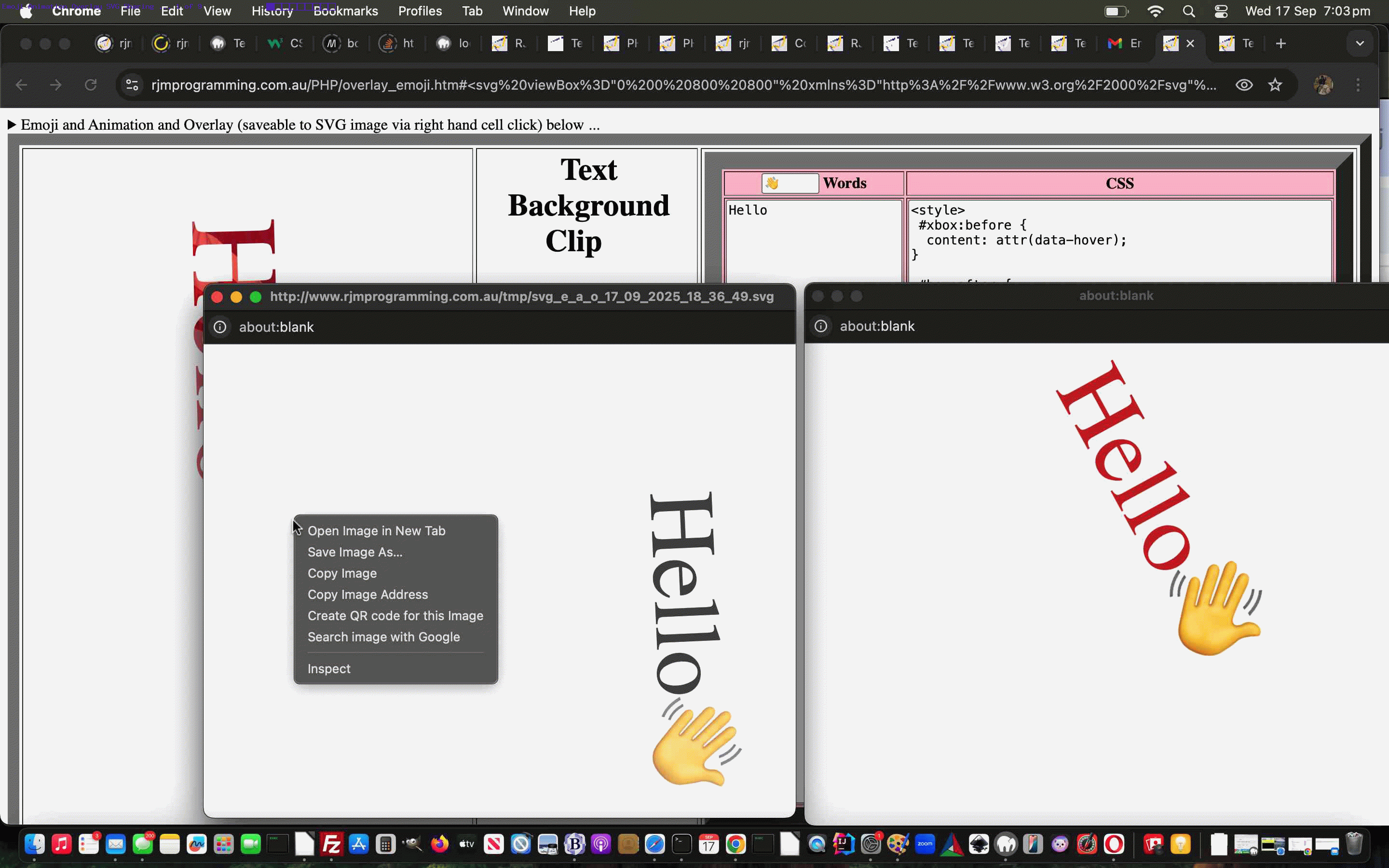
Text Background Clip Animation Emoji Overlay SVG Sharing Tutorial
Further to yesterday’s Text Background Clip Animation Emoji Overlay SVG Tutorial you start getting web browser support for context (ie. right click) menu options such as …
- Copy image
- Copy image address
- Save image as
… the latter effectively your “download option” when we can reach the HTML scenario whereby the user’s right click is over (an element such as) …
<img type="image/svg" src="//www.rjmprogramming.com.au/tmp/svg_e_a_o_17_09_2025_13_32_14.svg"></img>
… which today’s work is all about trying to achieve in adding more practical “export aid tools” into the “sharing mix”.
As with our last Media Gallery project, with our changed PHP helper signature_signature.php‘s …
<?php
if (isset($_POST['an_i_thingo'])) {
$ds=DIRECTORY_SEPARATOR;
if (isset($_POST['svg_filename'])) {
foreach (glob($_SERVER['DOCUMENT_ROOT'] . DIRECTORY_SEPARATOR . 'tmp' . DIRECTORY_SEPARATOR . 'svg_e_a_o_' . '*.*') as $dfilename) {
$filemtime = filemtime($dfilename);
if (time() - $filemtime >= 172800) { // 86400 seconds in a day
unlink($dfilename);
}
}
file_put_contents($_SERVER['DOCUMENT_ROOT'] . $ds . 'tmp' . $ds . '' . basename(str_replace('+',' ',urldecode($_POST['svg_filename']))), str_replace('+',' ',urldecode($_POST['an_i_thingo'])));
exit;
}
// rest of the usual if block
}
?>
… PHP code called into play via some Ajax Javascript calling …
var outfile='', wootoo=null;
var czhr=null, czform=null;
function ourprompt(svgoh) {
var oursvgoh=svgoh;
var tag=null;
var recipient='';
var dt=new Date();
var dsuff=('' + dt.toLocaleDateString() + ' ' + dt.toLocaleTimeString()).replace(/\:/g,'_').replace(/\ /g,'_').replace(/\//g,'_').replace(/\-/g,'_');
outfile='http://www.rjmprogramming.com.au/tmp/svg_e_a_o_' + dsuff + '.svg';
var xc=prompt('Optionally copy SVG below and save to a SVG file ( eg. text.svg ) that will open via a web browser Open File option ( eg. file:///Applications/MAMP/htdocs/test.svg ) or on a macOS MAMP local web server environment ( or http://localhost:8888/test.svg could also work here ). Or leave as is and use OK answer to save to URL ' + outfile + ' and display and/or share. To just email enter email address or to SMS enter a mobile number. An alternative filename suffix to ' + dsuff + ' is another OK answer option. Any other OK answers do nothing more.', svgoh);
if (xc == null) {
outfile='';
} else if (xc == svgoh) {
outfile=outfile;
} else if (xc.indexOf(' ') == -1 && xc.indexOf('@') != -1) {
recipient=xc;
tag = document.createElement('a');
tag.id='aem';
tag.target='_top';
tag.href='mailto:' + recipient + '?subject=Emoji%20Animated%20Overlay%20SVG%20image&body=' + encodeURIComponent(document.URL.split('?')[0].split('#')[0] + '#' + encodeURIComponent(svgoh.replace(' onclick="top.ourprompt(this.outerHTML);"', ' title="' + outfile + '"')));
tag.style.display='none';
document.body.appendChild(tag);
tag.click();
} else if (xc.trim() != '' && xc.indexOf(' ') == -1 && xc.replace(/0/g,'').replace(/1/g,'').replace(/2/g,'').replace(/3/g,'').replace(/4/g,'').replace(/5/g,'').replace(/6/g,'').replace(/7/g,'').replace(/8/g,'').replace(/9/g,'') == '') {
recipient=xc;
tag = document.createElement('a');
tag.id='aem';
tag.target='_top';
tag.href='sms:' + recipient + '&body=' + encodeURIComponent(document.URL.split('?')[0].split('#')[0] + '#' + encodeURIComponent(svgoh.replace(' onclick="top.ourprompt(this.outerHTML);"', ' title="' + outfile + '"')));
tag.style.display='none';
document.body.appendChild(tag);
tag.click();
} else if (xc.trim() != '' && xc.indexOf('<') == -1 && xc.indexOf(' ') == -1) {
outfile='http://www.rjmprogramming.com.au/tmp/svg_e_a_o_' + xc + '.svg';
} else if (xc.trim() != '' && xc.indexOf('<svg') == 0 && xc.indexOf('</svg>') != -1) {
oursvgoh='' + xc.split('</svg>')[0] + '</svg>';
} else {
outfile='';
}
if (outfile != '') {
czhr = new XMLHttpRequest();
czform = new FormData();
czform.append('an_i_thingo', oursvgoh);
czform.append('svg_filename', outfile);
czhr.onreadystatechange = showStuff;
czhr.open('post', '/HTMLCSS/signature_signature.php', true);
czhr.send(czform);
}
}
function showStuff() {
if (czhr != null) {
if (czhr.readyState == 4) {
if (czhr.status == 200) {
setTimeout(function(){
wootoo=window.open('','_blank','top=50,left=50,width=800,height=800');
wootoo.document.write('<html><body onload="document.title=document.body.title;" title="' + outfile + '"><img type="image/svg" src="//' + outfile.split('//')[1] + '"></img><scri' + 'pt type=text/javascript> setTimeout(function(){ document.title=document.body.title; }, 5000); </scr' + 'ipt></body></html>');
}, 1000);
}
}
}
}
… and where we set up an arrangement so that …
And if the two days is up (possible for an email or SMS link (again depending on hashtag methodologies) click after the initial action)? Well, we construct some SVG within a webpage for that scenario, but, as we say, that is not as cute, as far as web browser native functionality smarts go (though you can still View Page Source and work from there, for masochists out there), as when an actual SVG image file sits there on the web server, regarding the SVG sharably changed fifth draft version of a “Text Background Clip” client web application.
Previous relevant Text Background Clip Animation Emoji Overlay SVG Tutorial is shown below.
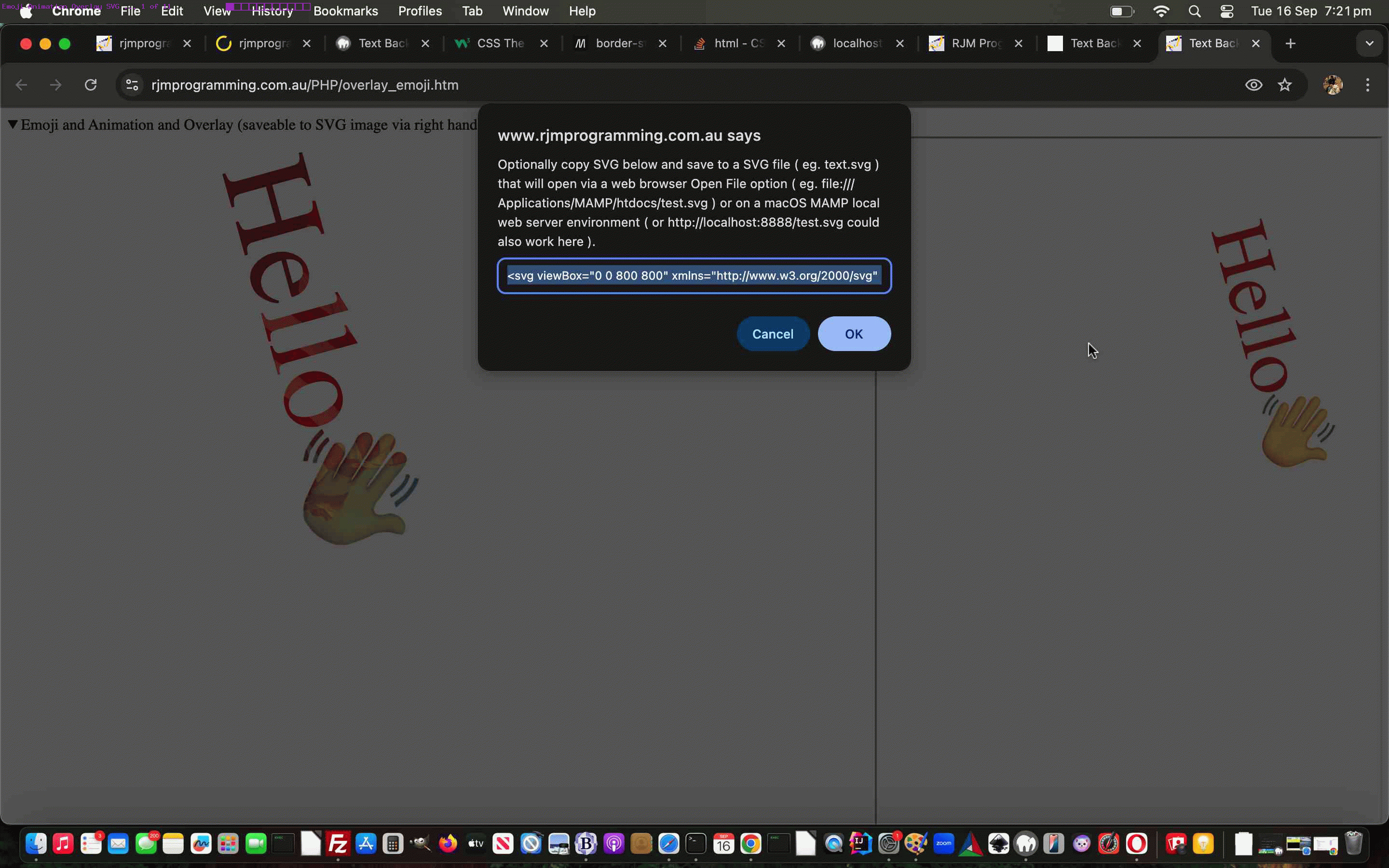
Text Background Clip Animation Emoji Overlay SVG Tutorial
As far as “heading towards creating a tool” from yesterday’s Text Background Clip Animation Emoji Overlay Tutorial‘s …
- emoji
- overlay
- animation
… work beginnings we’re harnessing SVG’s foreignObject subelement to start up that avenue (as some relief from the roads heading down lately).
SVG has it’s own animation abilities, but thinking we could simulate the keyframes and transitions CSS animations over the last couple of days sounded daunting. As were HTML5 canvas usage ideas. So we went down the foreignObject avenue and have been pleased we did, really. Those keyframes and transitions animations worked but we think the background text clipping may need more research or will pan out not to be translatable to the …
Standalone SVG image creator
… within our “reveal” details/summary hosting tool we hope to improve upon, from our start, today, in the SVG saveably changed fourth draft version of a “Text Background Clip” client web application.
Previous relevant Text Background Clip Animation Emoji Overlay Tutorial is shown below.
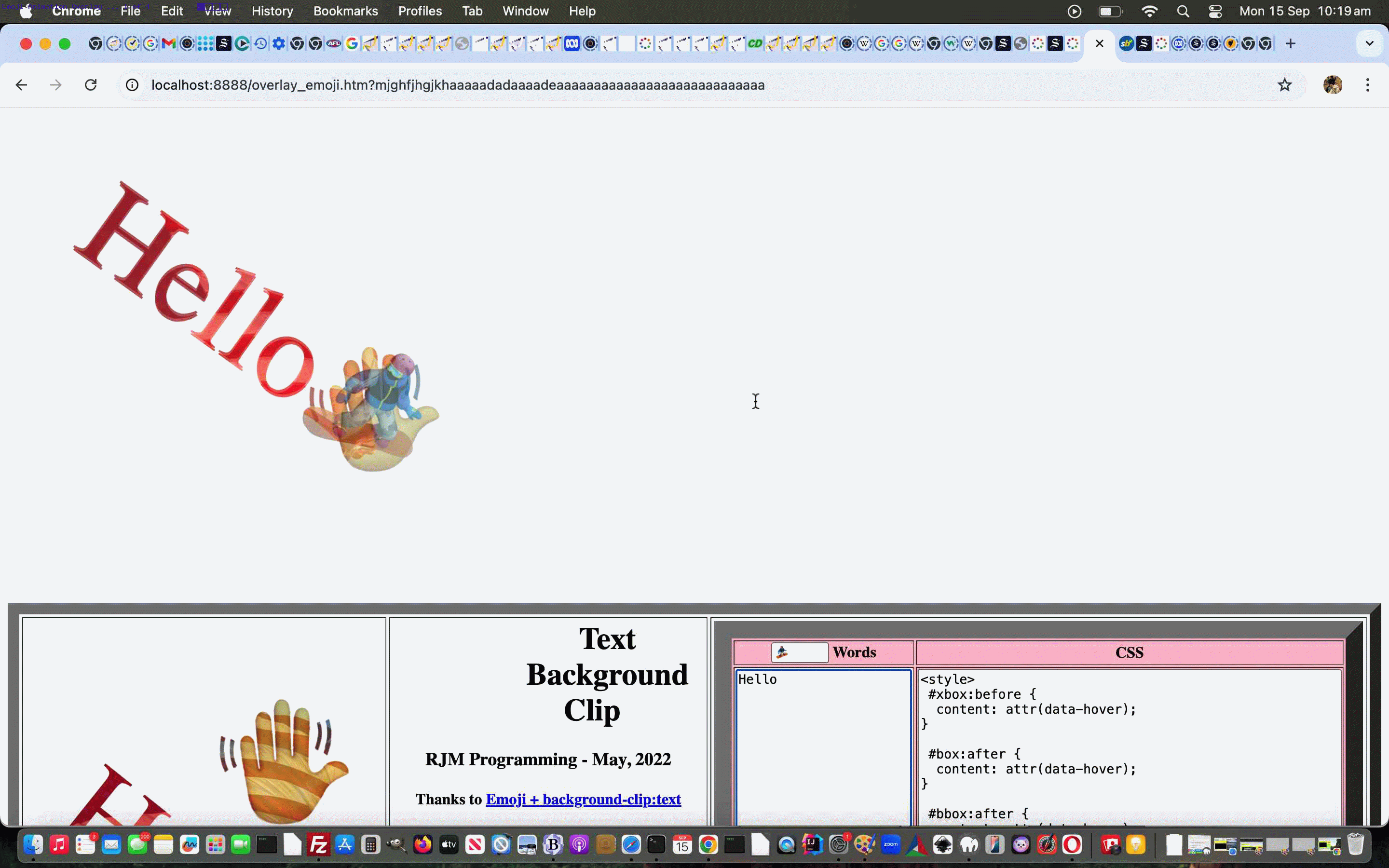
Text Background Clip Animation Emoji Overlay Tutorial
It’s “overlay day” onto yesterday’s Text Background Clip Animation Tutorial, and we like “overlay days” much better than any “underlay days” it’s got to be said … although?!
So what constitutes a good “overlay day” to us? It’s one that includes some/all of (the CSS concepts) …
- position: absolute;
- left: [position in X]px; top: [position in Y]px;
- opacity: [from 0 to 1];
- z-index: [the larger the more prominent];
… though the last we did not need so far, and the use of the great Javascript method [element].getBoundingClientRect() as exemplified by …
var rectis=document.getElementById('box').getBoundingClientRect();
document.getElementById('bbox').style.position='absolute';
document.getElementById('bbox').style.left='' + rectis.left + 'px';
document.getElementById('bbox').style.top='' + rectis.top + 'px';
document.getElementById('bbox').style.display='inline-block';
document.getElementById('box').className='box';
document.getElementById('bbox').className='box';
… where you will also see us better synchronizing the animation start by dynamically allocating element class (via Javascript DOM means) as close to the same time as possible in the “overlay” changed third draft version of a “Text Background Clip” client web application.
Previous relevant Text Background Clip Animation Tutorial is shown below.
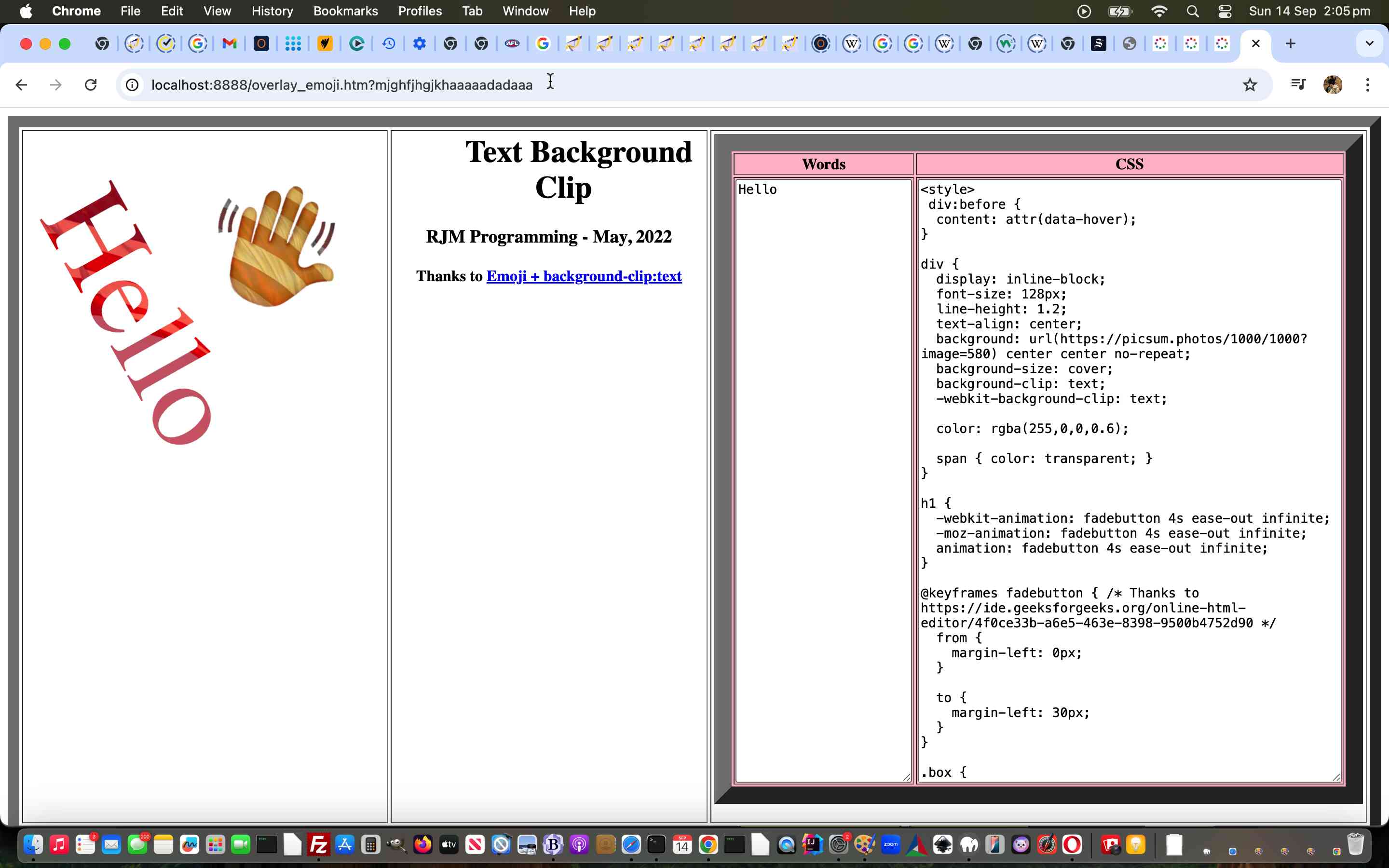
Text Background Clip Animation Tutorial
Today we’re returning to the work of Text Background Clip Primer Tutorial and adding a layer of …
Do It Yourself animation
… possibilities for the user. We grant you, the Text Background Clip aspects are, and remain, at least in our mind, the main talking point here, but it represents to us “a way in” (perhaps to a dead-end, but we are hoping not) regarding the concepts of …
- emoji
- overlay
- animation
… and this project had the first, and now we’re easing our way into the third today, with the reason we chose it as “a guinea pig” project being that textarea way the user has control. We want the user to explore possibilities themselves, and making it easier for us to see what’s possible regarding combinations of the three concepts above, we’re hoping, regarding the changed second draft version of a “Text Background Clip” client web application?!
Previous relevant Text Background Clip Primer Tutorial is shown below.
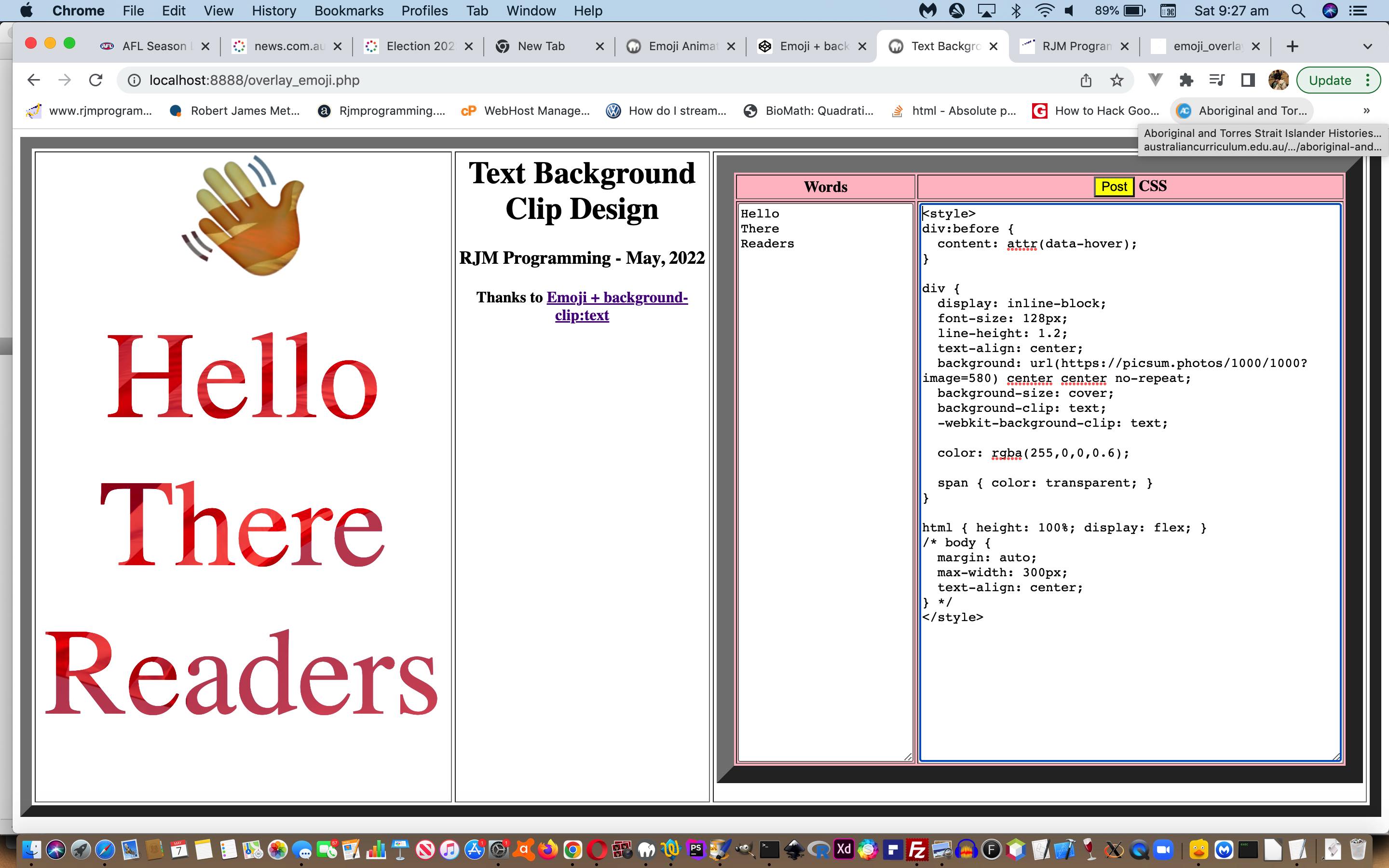
Text Background Clip Primer Tutorial
Again, today, we’re cloning and modifying a new “proof of concept” version of a “Text Background Clip” server web application …
And, again, it’s that “interactive input duo” of …
… forming that shareable dataset (helped out by diff and ed command line commands via PHP exec and shell_exec) whereby you can email or SMS your “creations” to other interested parties.
And, again, there is a “proof of concept” version of a “Text Background Clip” client web application choice of usage here, for you to try for yourself!
Previous relevant Emoji Animation Primer Tutorial is shown below.
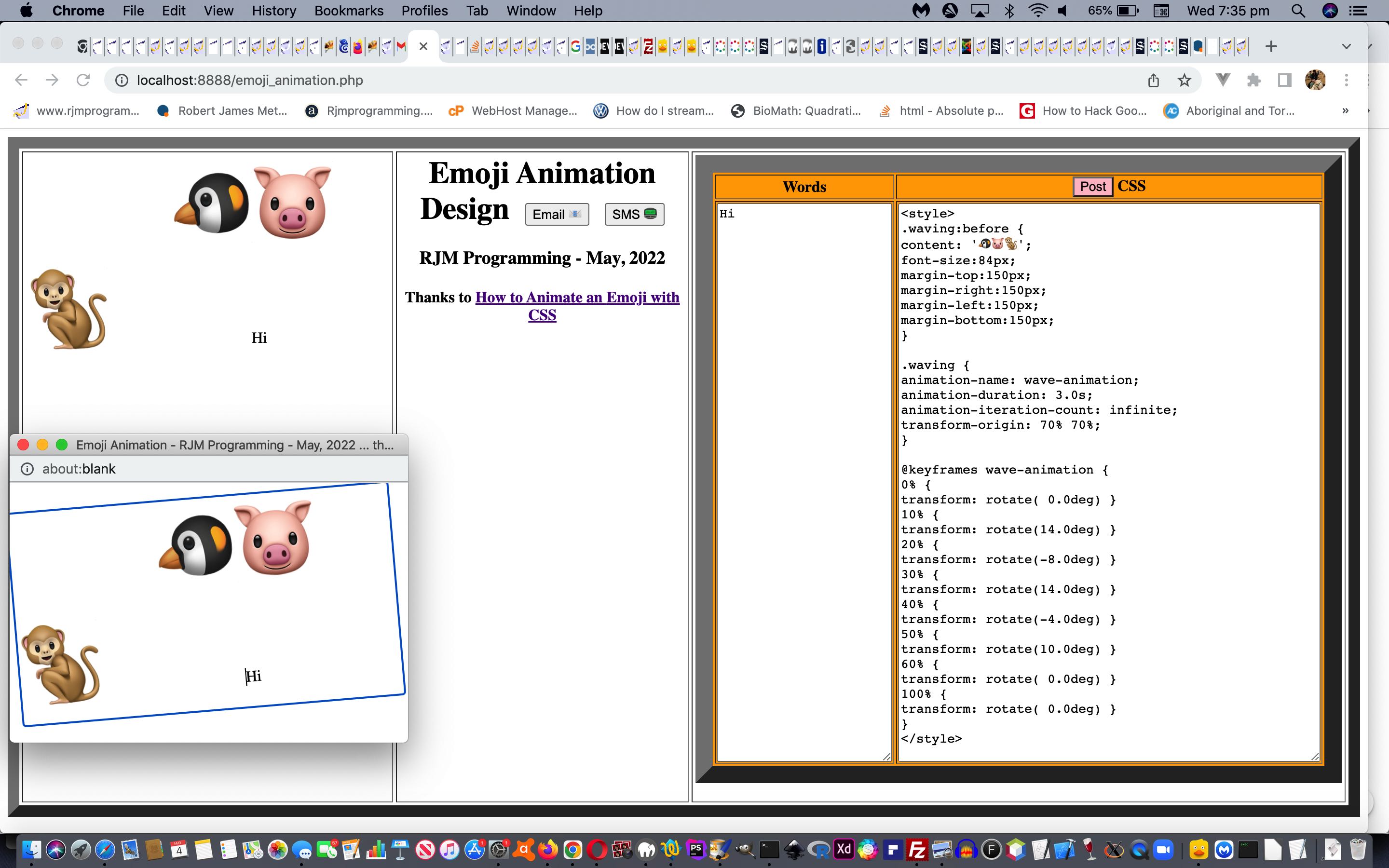
Emoji Animation Primer Tutorial
Today we’re cloning and modifying a new “proof of concept” version of an “Emoji Animation” server web application (or “proof of concept” client web application) …
We generally corral commonalities today when we think about cloning, and its here in spades regarding …
We break the “user controllable” components of the card into …
- wording of the card
- emoji (maybe) border of card CSS styling
… but just substitute “animation” for “border of card” or just “card” above. With help regarding the CSS above we’d like to thank How to Animate an Emoji with CSS.
We hope you try it out, creating your own webpages!
Previous relevant Simple Emoji Border Card Primer Tutorial is shown below.
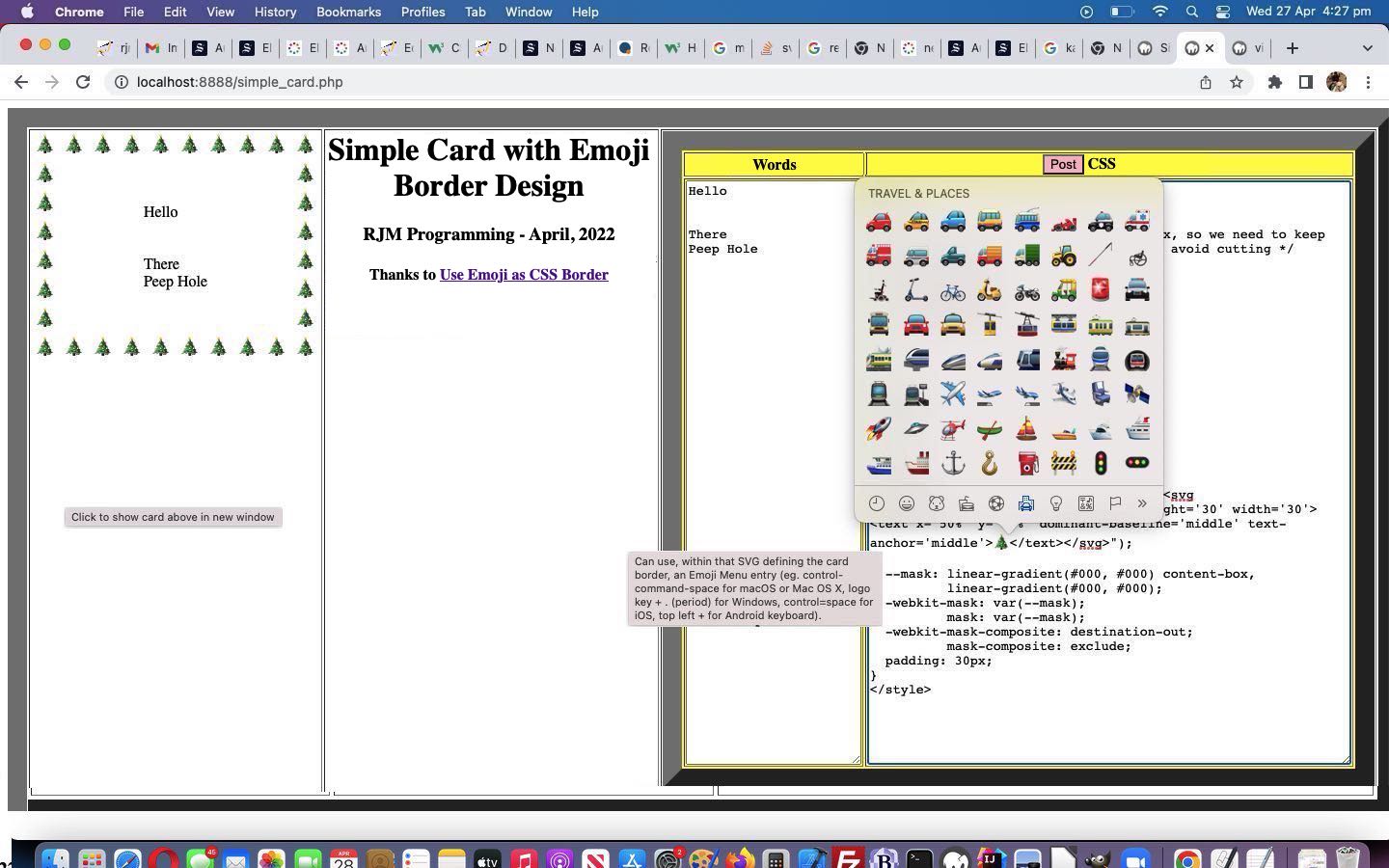
Simple Emoji Border Card Primer Tutorial
We were really happy to stumble upon StackOverflow‘s excellent Use Emoji as CSS Border webpage (of dreams and ideas) the other day, and immediately want to …
We break the “user controllable” components of the card into …
- wording of the card
- emoji (maybe) border of card CSS styling
… used by the user via some HTML textarea content they could edit to click a “Post” button creating their tailored (left hand table cell containing) HTML div element, that if double clicked (or just clicked within the surrounding table cell below the HTML “card” div) opens the user’s created card, alone, in a new window.
Previous relevant Emoji Animation CSS Block Tutorial is shown below.
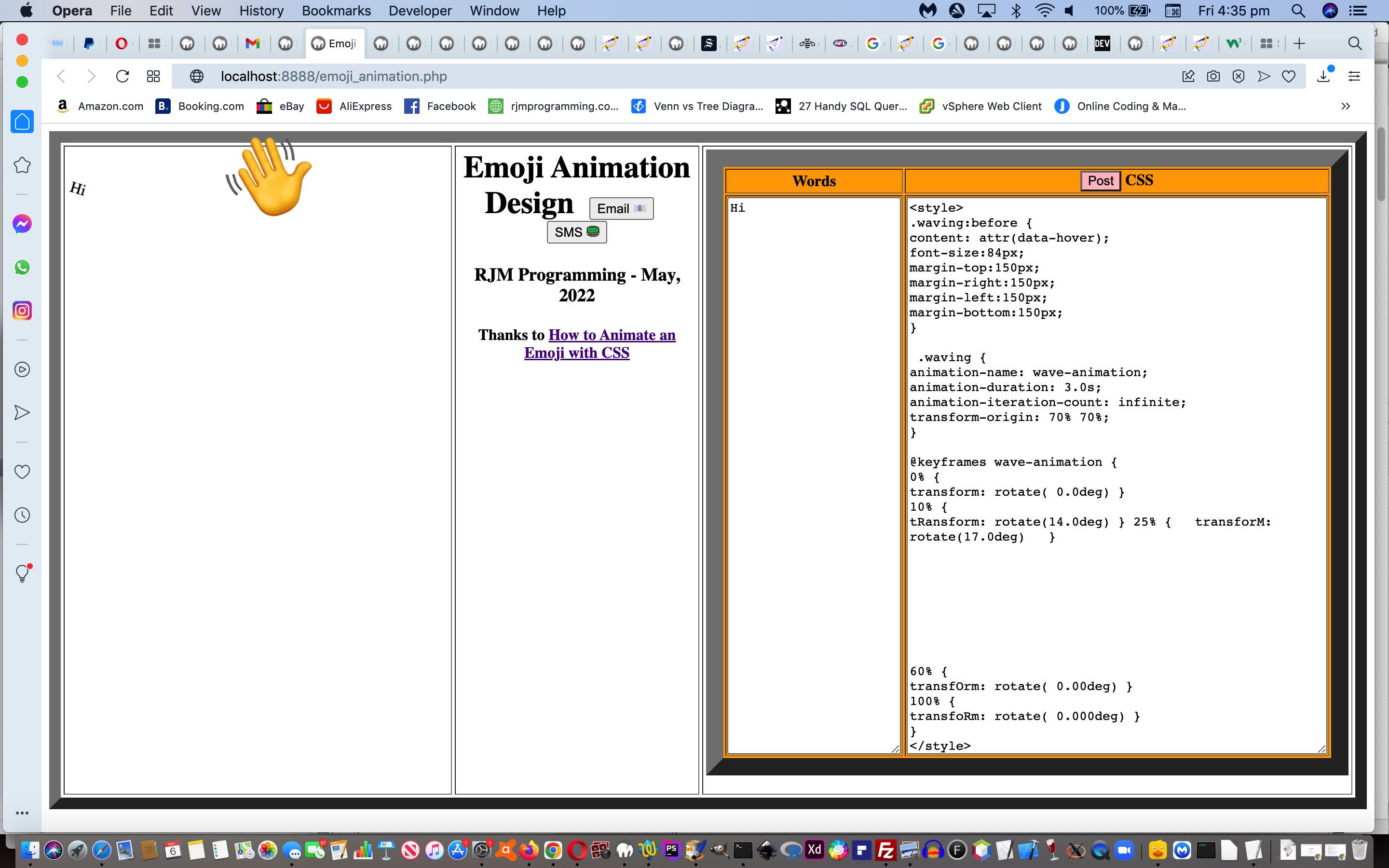
Emoji Animation CSS Block Tutorial
Do you recall a few days back, with Simple Emoji Border Card Sharing Tutorial how we avoided “too long” mailto: and/or sms: “a” link href arrangements, before we harnessed the command line combination of …
… the latter of which worked fine on this macOS system where we are writing this blog, but, sadly, not on our RJM Programming Linux web server? Well, we could install “ed”, but decided, instead, to “act like mister ed” with a new PHP function, which, today, caters for “ed asks” that might involve more than one line of change, with some “comma usages” can be seen explained, here, at ed – Use ed line oriented text editor – IBM Documentation. Here is the PHP function for your perusal …
<?php
function viacolon($instuff) {
//21c
// background: url("data:image/svg+xml,<svg xmlns='http://www.w3.org/2000/svg' height='30' width='30'><text x='50%' y='50%' dominant-baseline='middle' text-anchor='middle'></text></svg>");
//.
//13,14c
//.box:after {
// content: "Well I never";
//.
//w
$sprevln="";
$ldm=";";
$prevln='';
$inlns=explode("\n", $instuff);
$lns=file('/tmp/emoji_animation.diff');
foreach ($lns as $line_num => $ln) {
$lastinteresting=false;
if (($ln == 'w' || $ln == "w\n") && strpos($prevln, "d") !== false && strlen($prevln) <= 10 && strpos(trim($prevln), ' ') === false && strpos($prevln, ",") !== false) {
if (1 == 2) { $lastinteresting=true; }
$fromi=explode(",", explode("d", $prevln)[0])[0];
$toi=explode(",", explode("d", $prevln)[0])[1];
for ($fromtoi=$fromi; $fromtoi<=$toi; $fromtoi++) {
$instuff=str_replace_once(str_replace("\n", "", $inlns[-1 + $fromtoi]), " ", $instuff);
}
}
if (!$lastinteresting && $ln != '.' && $ln != 'w' && $ln != ".\n" && $ln != "w\n") {
if (strpos($ln, ':') !== false && (strpos($ln, ';') !== false || strpos($ln, '{') !== false)) {
if (strpos($ln, 'background:') === false) {
$bg=explode(':', $ln);
if (strpos($instuff, $bg[0] . ':') !== false) {
$ldm=";";
if (strpos($bg[1], ";") === false && strpos($bg[1], "{") !== false) { $ldm="{"; }
//if (strpos($bg[0], ".box") !== false) { file_put_contents('ax.ax', $instuff . "\n\n\n" . $bg[0] . ':' . explode($ldm, explode($bg[0] . ':', $instuff)[1])[0] . ':' . "\n\n\n" . $bg[0] . ':' . explode($ldm, explode($bg[0] . ':', file_get_contents('/tmp/emoji_animation.diff'))[1])[0] . "\n\n\n" . str_replace($bg[0] . ':' . explode($ldm, explode($bg[0] . ':', $instuff)[1])[0],$bg[0] . ':' . explode($ldm, explode($bg[0] . ':', file_get_contents('/tmp/emoji_animation.diff'))[1])[0],$instuff)); }
$instuff=str_replace_once($bg[0] . ':' . explode($ldm, explode($bg[0] . ':', $instuff)[1])[0],$bg[0] . ':' . explode($ldm, explode($bg[0] . ':', file_get_contents('/tmp/emoji_animation.diff'))[1])[0],$instuff);
} else if (strpos($prevln, "a") !== false) {
$fromi=explode(",", explode("a", $prevln)[0])[0];
$toi=$fromi;
$prefx=explode($inlns[-1 + explode("a", $prevln)[0]], $instuff)[0];
$instuff=str_replace_once(str_replace("\n", "", $inlns[-1 + explode("a", $prevln)[0]]), str_replace("\n", "", $inlns[-1 + explode("a", $prevln)[0]]) . " " . $bg[0] . ':' . explode(';', explode($bg[0] . ':', file_get_contents('/tmp/emoji_animation.diff'))[1])[0] . '; ', $instuff);
$inlns[-1 + explode("a", $prevln)[0]]=$inlns[-1 + explode("a", $prevln)[0]] . " " . $bg[0] . ':' . explode(';', explode($bg[0] . ':', file_get_contents('/tmp/emoji_animation.diff'))[1])[0] . '; ';
if (('' . $toi) == '1') {
//$instuff=str_replace_once(str_replace("\n", "", $inlns[-1 + $toi + $fromi]), " ", $instuff);
$sprevln="";
} else {
$toi--;
//$instuff=str_replace_once(str_replace("\n", "", $inlns[-1 + $toi + $fromi]), " ", $instuff);
$sprevln="" . $fromi . "a";
}
}
}
}
if (strlen($ln) <= 10 && str_replace("\n","", str_replace("d","", str_replace("c","", str_replace("a","", str_replace(",","", str_replace("0","", str_replace("1","", str_replace("2","", str_replace("3","", str_replace("4","", str_replace("5","", str_replace("6","", str_replace("7","", str_replace("8","", str_replace("9","",$ln))))))))))))))) == "") {
if (str_replace("\n","", str_replace("c","", str_replace("a","", str_replace(",","", str_replace("0","", str_replace("1","", str_replace("2","", str_replace("3","", str_replace("4","", str_replace("5","", str_replace("6","", str_replace("7","", str_replace("8","", str_replace("9","",$ln)))))))))))))) != "") {
$prevln=$ln;
}
}
//if (strlen($ln) <= 10 && str_replace("\n","", str_replace("c","", str_replace("a","", str_replace(",","", str_replace("0","", str_replace("1","", str_replace("2","", str_replace("3","", str_replace("4","", str_replace("5","", str_replace("6","", str_replace("7","", str_replace("8","", str_replace("9","",$ln)))))))))))))) == "") {
if (strlen($ln) <= 10 && str_replace("\n","", str_replace("d","", str_replace("c","", str_replace("A","", str_replace(",","", str_replace("0","", str_replace("1","", str_replace("2","", str_replace("3","", str_replace("4","", str_replace("5","", str_replace("6","", str_replace("7","", str_replace("8","", str_replace("9","",$ln))))))))))))))) == "") {
$instuff=$instuff;
} else if (strpos($prevln, "d") !== false && strlen($prevln) <= 10 && strpos(trim($prevln), ' ') === false && strpos($prevln, ",") === false) {
$instuff=str_replace_once(str_replace("\n", "", $inlns[-1 + explode("d", $prevln)[0]]), " ", $instuff);
} else if (strpos($prevln, "a") !== false && strlen($prevln) <= 10 && strpos(trim($prevln), ' ') === false && strpos($prevln, ",") === false) {
$fromi=explode(",", explode("a", $prevln)[0])[0];
$lnbig="";
$lni=(-1 + explode("a", $prevln)[0]);
$toi=$fromi;
$isok=true;
while (('' . $toi) != '0' && $isok) {
//$prefx=explode($inlns[-1 + explode("a", $prevln)[0]], $instuff)[0];
if ($ln == '.' || $ln == 'w' || $ln == ".\n" || $ln == "w\n") {
$isok=false;
$sprevln=$ln; //"";
} else if ($ln != '.' && $ln != 'w' && $ln != ".\n" && $ln != "w\n") {
//file_put_contents('/tmp/emoji_animation.zzz', $ln);
//file_put_contents('/tmp/emoji_animation.yyy', $prevln);
//$instuff=str_replace_once(str_replace("\n", "", $inlns[-1 + explode("a", $prevln)[0]]), str_replace("\n", "", $inlns[-1 + explode("a", $prevln)[0]]) . " " . $ln, $instuff);
//if (!file_exists('/tmp/emoji_animation.www')) { file_put_contents('/tmp/emoji_animation.www', $instuff); }
$lnbig.=' ' . str_replace("\n", "", $ln) . ' '; //$inlns[-1 + explode("a", $prevln)[0]]=$inlns[-1 + explode("a", $prevln)[0]] . " " . $ln;
}
if (('' . $toi) == '1') {
//$instuff=str_replace_once(str_replace("\n", "", $inlns[-1 + $toi + $fromi]), " ", $instuff);
//$instuff=str_replace_once(str_replace("\n", "", $ln), " ", $instuff);
$sprevln=$ln; //"";
$toi--;
$ln=$lns[($fromi - $toi) + $line_num];
} else {
$toi--;
//$instuff=str_replace_once(str_replace("\n", "", $inlns[-1 + $toi + $fromi]), " ", $instuff);
//$instuff=str_replace_once(str_replace("\n", "", $ln), " ", $instuff);
$sprevln="" . $fromi . "a";
$ln=$lns[($fromi - $toi) + $line_num];
}
}
$instuff=str_replace_once(str_replace("\n", "", $inlns[$lni]), str_replace("\n", "", $inlns[$lni]) . " " . $lnbig, $instuff);
//$inlns[$lni]=$inlns[$lni] . " " . $lnbig;
$sprevln=' ';
} else if (strpos($prevln, "c") !== false && strlen($prevln) <= 10 && strpos(trim($prevln), ' ') === false && strpos($prevln, ",") === false) {
$instuff=str_replace_once(str_replace("\n", "", $inlns[-1 + explode("c", $prevln)[0]]), str_replace("\n", "", $ln), $instuff);
} else if (strpos($prevln, "d") !== false && strlen($prevln) <= 10 && strpos(trim($prevln), ' ') === false && strpos($prevln, ",") !== false) {
$fromi=explode(",", explode("d", $prevln)[0])[0];
$toi=explode(",", explode("d", $prevln)[0])[1];
for ($fromtoi=$fromi; $fromtoi<=$toi; $fromtoi++) {
$instuff=str_replace_once(str_replace("\n", "", $inlns[-1 + $fromtoi]), " ", $instuff);
}
//$instuff=str_replace(str_replace("\n", "", $inlns[-1 + $fromi]), " ", $instuff);
//if ($fromi != $toi) {
// $fromi++;
// $sprevln="" . $fromi . "," . $toi . "d";
//} else {
$sprevln=$ln;
//}
} else if (strpos($prevln, "c") !== false && strlen($prevln) <= 10 && strpos(trim($prevln), ' ') === false && strpos($prevln, ",") !== false) {
$origln=$ln;
$lnbig='';
$isokay=true;
$fromi=explode(",", explode("c", $prevln)[0])[0];
$toi=explode(",", explode("c", $prevln)[0])[1];
$one=1;
$ln=$lns[$one + $line_num];
while ($ln != '.' && $ln != 'w' && $ln != ".\n" && $ln != "w\n") {
$lnbig.=' ' . str_replace("\n", "", $ln) . ' ';
$one++;
$ln=$lns[$one + $line_num];
}
$instuff=str_replace_once(str_replace("\n", "", $inlns[-1 + $fromi]), str_replace("\n", "", $origln) . $lnbig, $instuff);
if ($fromi != $toi) {
$fromi++;
$sprevln="" . $fromi . "," . $toi . "c";
for ($fromtoi=$fromi; $fromtoi<=$toi; $fromtoi++) {
$instuff=str_replace_once(str_replace("\n", "", $inlns[-1 + $fromtoi]), " ", $instuff);
}
} else {
$sprevln=$ln;
}
}
if ($sprevln != "") {
$prevln=$sprevln;
$sprevln="";
} else {
$prevln=$ln;
}
if (strpos($prevln, "d") !== false && strlen($prevln) <= 10 && strpos(trim($prevln), ' ') === false && strpos($prevln, ",") === false) {
$instuff=str_replace_once(str_replace("\n", "", $inlns[-1 + explode("d", $prevln)[0]]), " ", $instuff);
}
}
}
return $instuff;
}
function str_replace_once($needle, $replace, $haystack) { // thanks to https://stackoverflow.com/questions/1252693/using-str-replace-so-that-it-only-acts-on-the-first-match
$newstring=$haystack;
$pos = strpos($haystack, $needle);
if ($pos !== false) {
$newstring = substr_replace($haystack, $replace, $pos, strlen($needle));
}
return $newstring;
}
?>
… improving on yesterday’s Emoji Animation Primer Tutorial.
That work not only helped out with the changed “proof of concept” Emoji Animation server web application, but also with (its “clone partner”) the changed “proof of concept” Card with Emoji Border Design client web application.
Previous relevant Emoji Animation Primer Tutorial is shown below.

Emoji Animation Primer Tutorial
Today we’re cloning and modifying a new “proof of concept” version of an “Emoji Animation” server web application (or “proof of concept” client web application) …
We generally corral commonalities today when we think about cloning, and its here in spades regarding …
We break the “user controllable” components of the card into …
- wording of the card
- emoji (maybe) border of card CSS styling
… but just substitute “animation” for “border of card” or just “card” above. With help regarding the CSS above we’d like to thank How to Animate an Emoji with CSS.
We hope you try it out, creating your own webpages!
Previous relevant Simple Emoji Border Card Primer Tutorial is shown below.

Simple Emoji Border Card Primer Tutorial
We were really happy to stumble upon StackOverflow‘s excellent Use Emoji as CSS Border webpage (of dreams and ideas) the other day, and immediately want to …
We break the “user controllable” components of the card into …
- wording of the card
- emoji (maybe) border of card CSS styling
… used by the user via some HTML textarea content they could edit to click a “Post” button creating their tailored (left hand table cell containing) HTML div element, that if double clicked (or just clicked within the surrounding table cell below the HTML “card” div) opens the user’s created card, alone, in a new window.
If this was interesting you may be interested in this too.
If this was interesting you may be interested in this too.
If this was interesting you may be interested in this too.
If this was interesting you may be interested in this too.
If this was interesting you may be interested in this too.
If this was interesting you may be interested in this too.
If this was interesting you may be interested in this too.
If this was interesting you may be interested in this too.
If this was interesting you may be interested in this too.


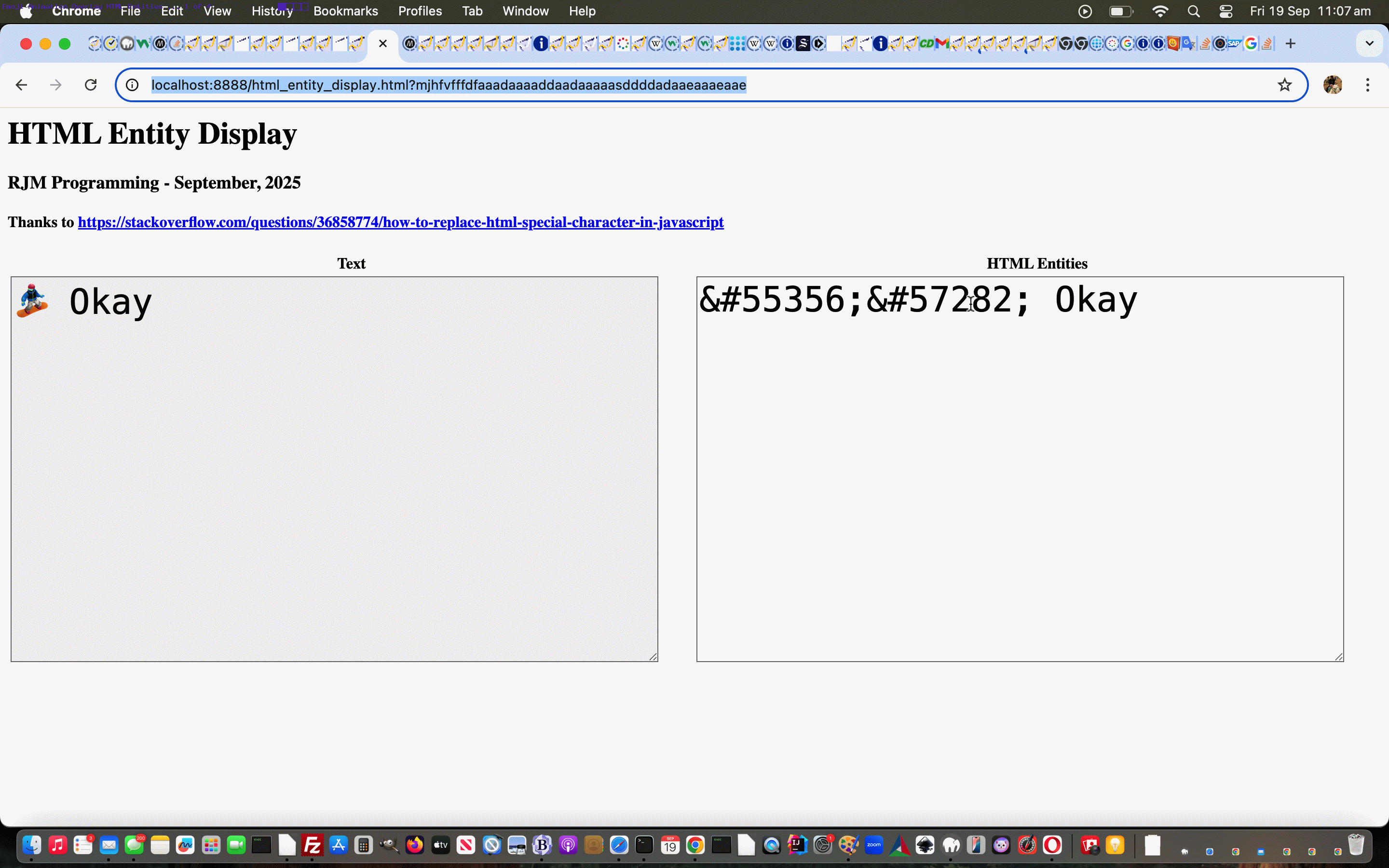











WordPress Blog Comments URL Right Click Popup Check Prevent Default Tutorial
WordPress Blog Comments URL Right Click Popup Check Prevent Default Tutorial
We’re coming back to the previous WordPress administrator Comment moderation section URL Popup Window Checker functionality last talked about with WordPress Blog Comments URL Right Click Popup Check Tutorial.
We were finding before this Javascript code fix …
<?php
setTimeout(function(){
if (document.body.innerHTML.indexOf('Comments</h1>') != -1) {
var als=document.getElementsByTagName('a');
for (var ials=0; ials<als.length; ials++) {
if (('' + als[ials].href).indexOf('http') == 0 && ('' + als[ials].href).replace('wordpress.org','rjmprogramming.com.au').indexOf('rjmprogramming.com.au') == -1) {
als[ials].oncontextmenu=function(evt){ evt.stopPropagation(); evt.preventDefault(); if (woowoo) { if (!woowoo.closed) { !woowoo.close(); woowoo=null; } } woowoo=window.open(evt.target.href, '_blank', 'left=' + eval(-480 + eval('' + screen.width)) + ',top=0,width=500,height=200'); setTimeout(function(){ woowoo.focus(); }, 500); };
als[ials].ontouchend=function(evt){ evt.stopPropagation(); evt.preventDefault(); if (woowoo) { if (!woowoo.closed) { !woowoo.close(); woowoo=null; } } woowoo=window.open(evt.target.href, '_blank', 'left=' + eval(-480 + eval('' + screen.width)) + ',top=0,width=500,height=200'); setTimeout(function(){ woowoo.focus(); }, 500); };
}
}
}
}, 6000);
?>
… in admin-header.php that popup windows were being created but immediately falling behind the main WordPress blog “admin” section Comments section webpage window, annoyingly. Our investigations tracked it down to the right click “default behaviour” forcing the popup window out of view.
The remedy being? Anyone, anyone?
.
.
.
.
No takers … how about a hint? … It starts with
.
.
.
.
p
.
.
.
… no takers … then with
.
.
.
.
r
.
.
.
… no takers … then with
.
.
.
.
e
.
.
.
… no takers … then with
.
.
.
.
v
.
.
.
… no takers … then with
.
.
.
.
e
.
.
.
.
… finally, yes Nicola … are you saying “Preve Fountain” …
.
.
.
Alas, no … and it’s not Spanish Steps or Pantheon or Colosseum or Trevi Fountain or Piazza Venezia or Saint Peter’s Square either, if that helps … Anyone else?
.
.
.
.
… yes, Audrey?
.
.
… you’re saying “The Mouth of Truth”?
.
.
… no, sorry, no doubt it was on the tip of your collective tongues, when we say it’s …
event.preventDefault();
… thank you, Sage … preventing that right click menu from appearing, and so not compromising window focus web browser rendering. We do very little WordPress administration on mobile, but just in case, we added an ontouchend event (usually happening at the finish of a gesture) mimicking of the non-mobile right click logic, for good measure.
Previous relevant WordPress Blog Comments URL Right Click Popup Check Tutorial is shown below.
WordPress Blog Comments URL Right Click Popup Check Tutorial
In the past we have only mildly changed the administration section of our TwentyTen themed WordPress.org blog (you are currently reading) here at RJM Programming, and some of that involved new WordPress plugins, as you can read a bit about with WordPress Blog Data URI in Post Plugin Tutorial.
We maintain that blog within an “admin” part of the WordPress blog, and any changes we’d put in a “des
sert island wish list” usually just absorb and move on, but we thought we’d improve on …WordPress comment moderation
… by allowing myself (well, thanks awfully, I don’t really know what to say) the chance to …
… because, even if we wanted to argue with the great Akismet (we use and are very happy with around here) calling it spam, one of the steps we’d want to investigate would be to rule out a potential “broken link”, and this is a way to check for that.
Now, what we discovered marrying “a wish” with “an action plan” was that …
… with our action plan moving to “deployment” via PHP (writes Javascript) admin-header.php modified code …
<?php
<script type="text/javascript">
document.body.className = document.body.className.replace('no-js','js');
setTimeout(function(){
if (document.body.innerHTML.indexOf('Comments</h1>') != -1) {
var als=document.getElementsByTagName('a');
for (var ials=0; ials<als.length; ials++) {
if (('' + als[ials].href).indexOf('http') == 0 && ('' + als[ials].href).replace('wordpress.org','rjmprogramming.com.au').indexOf('rjmprogramming.com.au') == -1) {
als[ials].oncontextmenu=function(evt){ window.open(evt.target.href, '_blank', 'left=' + eval(-500 + eval('' + screen.width)) + ',top=0,width=500,height=200'); };
}
}
}
}, 6000);
</script>
?>
Pretty straightforward really, and perhaps of interest to some WordPress.org comment moderators out there!
Previous relevant WordPress Blog Data URI in Post Plugin Tutorial is shown below.
WordPress Blog Data URI in Post Plugin Tutorial
Today, we’ve got another WordPress plugin to suit the TwentyTen themed blog you are reading, adding onto those described at WordPress Blog Collaborative Annotated Email FormData Post Tutorial.
This plugin suits the Content Editor creating the posts in the administration end of the WordPress TwentyTen themed blog, when they desire to add a data URI, rather than an absolute URL or relative URL (which would probably involve an upload). To use data URIs will make your blog posts independent of web server file arrangements, but if you are looking for this to save (web server) diskspace, this might be a mute point. The diskspace could still be used up by the MySql database storing the data URI in its base64 encoding.
What does our PHP plugin call on to do its
thangthing?And so we have for you today rjmprogramming-data-uri-helper.php PHP source code that goes into this plugin should you want to write your own version for a theme that isn’t the WordPress TwentyTen theme (looking for those TwentyTen “id”s and “className”s as changepoints), and/or view us using it with today’s animated GIF presentation.
Previous relevant WordPress Blog Collaborative Annotated Email FormData Post Tutorial is shown below.
WordPress Blog Collaborative Annotated Email FormData Post Tutorial
Yesterday’s WordPress Blog Collaborative Annotated Email User Experience Tutorial helped with practicalities regarding user experience with this WordPress Blog highlighting of text accumulated into the body (as HTML attachment) and subject (as text) of an Annotated Email form of collaborative communication.
The “subject” extension here makes it all the more important to try to look out for long email URLs that will exceed the web server limit here. When too long, that …
… and today we do not write out any discrete HTML form element to do this (when required), but instead resort to the wonderfully powerful combination of …
… to be used by the new dynamic thinking Javascript function as below …
function iftoolongpost(prefixu, restsub, restu) {
var prefixrest=prefixu.replace('&body=', encodeURIComponent(restsub) + '&body=') + restu;
if ((prefixrest).length > 900) {
// dynamic form
var xhr = new XMLHttpRequest();
var form=new FormData();
form.append('to', decodeURIComponent(prefixrest.split('to=')[1].split('&')[0]));
form.append('subject', decodeURIComponent(prefixrest.split('subject=')[1].split('&')[0]));
form.append('body', decodeURIComponent(prefixrest.split('body=')[1].split('&')[0]));
xhr.open('post', '//www.rjmprogramming.com.au/HTMLCSS/emailhtml.php', true);
xhr.send(form);
// end of dynamic form
location.href='#hfloater';
} else {
document.getElementById('aeciframe').src=prefixrest;
}
}
… called in that different calling arrangement as per …
document.getElementById('hfloater').innerHTML+='<b>Annotated Email <a class="hlclass" style="inline-block;cursor:pointer;text-decoration:none;" onclick="iftoolongpost(this.title, encodeURIComponent((this.innerText || this.contentWindow || this.contentDocument)), encodeURIComponent(this.innerHTML.substring(this.innerHTML.indexOf(String.fromCharCode(60)))));" data-href="//www.rjmprogramming.com.au/HTMLCSS/emailhtml.php?to=&subject=Re%3a%20' + encodeURIComponent(document.title.split('|')[0]) + '%20%28' + encodeURIComponent(document.URL) + '%29%0a&body=" title="//www.rjmprogramming.com.au/HTMLCSS/emailhtml.php?to=&subject=Re%3a%20' + encodeURIComponent(document.title.split('|')[0]) + '%20%28%20' + encodeURIComponent(document.URL) + '%20%29%0a&body=" target=aeciframe onmouseover="this.title=emaileeis(this.title);" ontouchstart="this.title=emaileeis(this.title);" id=b_hfloater_annotated_email>' + aec + '</a></b><iframe id=aeciframe name=aeciframe style=display:none; src=#></iframe><br>';
… featuring in changed PHP rjmprogramming-multi-lookup.php plugin and/or changed TwentyTen theme header.php file.
Previous relevant WordPress Blog Collaborative Annotated Email User Experience Tutorial is shown below.
WordPress Blog Collaborative Annotated Email User Experience Tutorial
Did you try yesterday’s WordPress Blog Collaborative Annotated Email Tutorial highlighting of text Annotated Email functionality? If you did, you might have found a “hair trigger” timed user experience. You had a very small amount of time to decide on any amendments “by hand” to your email.
On this, did you notice how we relied on a Javascript prompt window to garner an email address off the user? There is method in this “kludginess”. We wanted the highlighting not to be destroyed by a change of focus. The downside though, is that the whole time you spend answering contributes to any setTimeout based timing we have going before we automatically make the highlighting functionality menu disappear. Today, we control that, waiting an extra 10 seconds or so after that for the user to start entering their own Annotated Email content, should they wish, and the HTML div contenteditable=true is reminded by a new onchange replenishment of the delay that the user is still writing … a bit like with SMSes and those blinking dots telling you the other SMSer is writing something (but not as cute here, looks wise, alas).
Again, into the WordPress (changed PHP rjmprogramming-multi-lookup.php) plugin or header.php the changed (header.php) code involves new Javascript (that dynamically creates HTML) as per …
var mpn='', eod='', aec='', withindiv=0;
function emaileeis(inideais) {
var presm='', postsm='';
if (inideais.indexOf(':') != -1) {
presm=inideais.split(':')[0] + ':';
postsm=inideais.replace(presm,'');
} else if (inideais.indexOf('?to=') != -1) {
presm=inideais.split('?to=')[0] + '?to=';
if (inideais.indexOf('&') != -1) {
postsm=inideais.replace(presm,'').replace(inideais.split('?to=')[1].split('&')[0],'');
}
} else if (inideais.indexOf('&') != -1) {
presm=inideais.split('&')[0] + '&';
postsm=inideais.replace(presm,'');
} else {
presm=inideais.split('?')[0];
postsm=inideais.replace(presm,'');
}
if (eod == '') {
if (inideais.indexOf('?to=') != -1) {
eod=inideais.split('?to=')[1].split('&')[0];
}
var pwithindiv=withindiv;
withindiv=9000;
eod=prompt('Enter email address', eod);
if (pwithindiv == 0) {
withindiv=0.9999;
} else {
withindiv=pwithindiv;
}
if (eod == null) {
eod='';
}
}
return presm + encodeURIComponent(eod) + postsm;
}
function smsee(inideais) {
var presm='', postsm='';
if (inideais.indexOf(':') != -1) {
presm=inideais.split(':')[0] + ':';
}
if (inideais.indexOf('&') != -1) {
postsm='&' + inideais.split('&')[1];
}
if (mpn == '') {
if (inideais.indexOf(':') != -1) {
mpn=inideais.split(':')[1].split('&')[0];
}
var pwithindiv=withindiv;
withindiv=9000;
mpn=prompt('Enter phone number for SMS (or Cancel to do it at the Messager app', mpn);
if (pwithindiv == 0) {
withindiv=0.9999;
} else {
withindiv=pwithindiv;
}
if (mpn == null) {
mpn='';
}
}
return presm + mpn + postsm;
}
function lookforhighlight() {
var usualdelay=2000, oRange=null, oRect=null, s_top='0px', s_left='5px', opis='', fourhundred=300, isfx='0', otit='';
if (hight == ' ') {
setTimeout(lfhlater, 5000);
hight='';
xcbackc=cookieHHVal('linktoothers');
if (xcbackc != '') {
oharr=xcbackc.split('|');
}
}
if (('' + withindiv).indexOf('.') != -1) {
setTimeout(lookforhighlight, eval(('' + withindiv).split('.')[1]));
withindiv=eval(('' + withindiv).split('.')[0]);
return;
} else if (withindiv != 0) {
setTimeout(lookforhighlight, withindiv);
return;
} else {
setTimeout(lookforhighlight, usualdelay);
}
var xsel=window.getSelection().toString();
if (xsel.length == 0) {
try {
xsel=document.selection.createRange().htmlText;
xsel=xsel.replace(String.fromCharCode(10),' ').replace(String.fromCharCode(10),' ').replace(String.fromCharCode(10),' ').replace(String.fromCharCode(10),' ');
xsel=xsel.replace(String.fromCharCode(13),' ').replace(String.fromCharCode(13),' ').replace(String.fromCharCode(13),' ').replace(String.fromCharCode(13),' ');
} catch(ertw) {
xsel='';
}
} else {
xsel=xsel.replace(String.fromCharCode(10),' ').replace(String.fromCharCode(10),' ').replace(String.fromCharCode(10),' ').replace(String.fromCharCode(10),' ');
xsel=xsel.replace(String.fromCharCode(13),' ').replace(String.fromCharCode(13),' ').replace(String.fromCharCode(13),' ').replace(String.fromCharCode(13),' ');
if (xsel != hight && xsel != '') {
oRange = window.getSelection().getRangeAt(0); //get the text range
oRect = oRange.getBoundingClientRect();
s_top = ('' + oRect.top).replace('px','') + 'px';
s_left = ('' + oRect.left).replace('px','') + 'px';
if (s_top != '0px') {
fourhundred=eval('' + s_top.replace('px',''));
s_top='0px';
var dse='', dde='';
if (document.scrollingElement) {
if (document.scrollingElement.scrollTop) {
dse=('' + document.scrollingElement.scrollTop);
}
}
if (document.documentElement) {
if (document.documentElement.scrollTop) {
dde=('' + document.documentElement.scrollTop);
}
}
if (dse != '') {
fourhundred+=eval('' + dse.replace('px',''));
isfx='0';
} else if (dde != '') {
fourhundred+=eval('' + dde.replace('px',''));
isfx='0';
} else if (('' + window.scrollY) != '') {
fourhundred+=eval('' + ('' + window.scrollY).replace('px',''));
isfx='0';
} else if (('' + window.pageYOffset) != '') {
fourhundred+=eval('' + ('' + window.pageYOffset).replace('px',''));
isfx='0';
} else {
isfx=('' + document.body.scrollTop).replace('px','');
if (isfx.replace('0','') == '') {
isfx=('' + document.scrollingElement.scrollTop).replace('px','');
if (isfx.replace('0','') == '') {
isfx=('' + window.scrollY).replace('px','');
if (isfx.replace('0','') == '') {
isfx=('' + window.pageYOffset).replace('px','');
}
}
}
}
fourhundred+=100;
}
}
}
if (xsel != hight && xsel != '') {
hight=xsel;
if (s_top == '0px') { s_top = ('' + eval(fourhundred + eval('' + isfx))) + 'px'; }
if (aec == '') {
aec=' 📧 <div id=daec contenteditable=true onblur="withindiv=0;" onchange="withindiv=9000;" onclick="withindiv=9000; event.stopPropagation();"> </div>';
} else if (document.getElementById('daec') && document.getElementById('b_hfloater_annotated_email')) {
aec=document.getElementById('b_hfloater_annotated_email').innerHTML;
}
if (aec.indexOf('<mark>' + hight + '</mark>') == -1) {
if ((' ' + aec).slice(-14).substring(0,1).replace('?','.').replace('!','.') == '.') {
aec=aec.replace('</div>', ' <mark>' + hight + '</mark></div>');
} else {
aec=aec.replace('</div>', ' <mark>' + hight + '</mark></div>');
}
}
if (document.getElementById('hfloater')) {
if (document.getElementById('hfloater').innerHTML == '') {
document.getElementById('hfloater').style.position='absolute';
document.getElementById('hfloater').style.top=s_top;
document.getElementById('hfloater').style.left=s_left;
document.getElementById('hfloater').style.zIndex='87';
document.getElementById('hfloater').style.backgroundColor='rgba(255,165,0,0.9)';
document.getElementById('hfloater').style.border='1px solid purple';
document.getElementById('hfloater').style.padding='2px 2px 2px 2px';
document.getElementById('hfloater').style.display='block';
document.getElementById('hfloater').innerHTML='<b>Wikipedia <a class="hlclass" style="inline-block;" href="//wikipedia.org/wiki/Main_Page" title="//wikipedia.org/wiki/" target=_blank onmouseover="this.href=this.title + hight.replace(/\ /g,' + "'_'" + ');" ontouchstart="this.href=this.title + hight.replace(/\ /g,' + "'_'" + ');" id=b_hfloater_wikipedia>' + hight + '</a></b><br>';
document.getElementById('hfloater').innerHTML+='<b>Google Translate <a class="hlclass" style="inline-block;" href="//translate.google.com" title="//translate.google.com/#view=home&op=translate&sl=auto&tl=en&text=" target=_blank onmouseover="this.href=this.title + encodeURIComponent(hight);" ontouchstart="this.href=this.title + encodeURIComponent(hight);" id=b_hfloater_google_translate>' + hight + '</a></b><br>';
document.getElementById('hfloater').innerHTML+='<b>Free Dictionary <a class="hlclass" style="inline-block;" href="//www.thefreedictionary.com/" title="//www.thefreedictionary.com/" target=_blank onmouseover="this.href=this.title + hight.replace(/\ /g,' + "'+'" + ');" ontouchstart="this.href=this.title + hight.replace(/\ /g,' + "'+'" + ');" id=b_hfloater_free_dictionary>' + hight + '</a></b><br>';
document.getElementById('hfloater').innerHTML+='<b>Google Search <a class="hlclass" style="inline-block;" href="//www.google.com/" title="//www.google.com/search?q=" target=_blank onmouseover="this.href=this.title + hight.replace(/\ /g,' + "'+'" + ');" ontouchstart="this.href=this.title + hight.replace(/\ /g,' + "'+'" + ');" id=b_hfloater_google_search>' + hight + '</a></b><br>';
document.getElementById('hfloater').innerHTML+='<b>Tag Search <a class="hlclass" style="inline-block;" href="//www.rjmprogramming.com.au/ITblog/" title="//www.rjmprogramming.com.au/ITblog/tag/" target=_blank onmouseover="this.href=this.title + hight.replace(/\ /g,' + "'-'" + ');" ontouchstart="this.href=this.title + hight.replace(/\ /g,' + "'-'" + ');" id=b_hfloater_tag_search>' + hight + '</a></b><br>';
document.getElementById('hfloater').innerHTML+='<b>Category Search <a class="hlclass" style="inline-block;" href="//www.rjmprogramming.com.au/ITblog/" title="//www.rjmprogramming.com.au/ITblog/category/" target=_blank onmouseover="this.href=this.title + hight.replace(/\ /g,' + "'-'" + ');" ontouchstart="this.href=this.title + hight.replace(/\ /g,' + "'-'" + ');" id=b_hfloater_category_search>' + hight + '</a></b><br>';
document.getElementById('hfloater').innerHTML+='<b>Tag First Word Search <a class="hlclass" style="inline-block;" href="//www.rjmprogramming.com.au/ITblog/" title="//www.rjmprogramming.com.au/ITblog/tag/" target=_blank onmouseover="this.href=this.title + hight.replace(/\ /g,' + "'-'" + ').replace(' + "'-','/?wopenall='" + ');" ontouchstart="this.href=this.title + hight.replace(/\ /g,' + "'-'" + ').replace(' + "'-','/?wopenall='" + ');" id=b_hfloater_tag_first_word_search>' + hight + '</a></b><br>';
document.getElementById('hfloater').innerHTML+='<b>Posting Title Search <a class="hlclass" style="inline-block;" href="//www.rjmprogramming.com.au/itblog/match/mapper.php" title="//www.rjmprogramming.com.au/itblog/match/mapper.php?pm=" target=_blank onmouseover="this.href=this.title + encodeURIComponent(hight);" ontouchstart="this.href=this.title + encodeURIComponent(hight);" id=b_hfloater_posting_title_search>' + hight + '</a></b><br>';
document.getElementById('hfloater').innerHTML+='<b>Email <a class="hlclass" style="inline-block;" href="mailto:?subject=Re%3a%20' + encodeURIComponent(thetwords) + '%20%28' + encodeURIComponent(document.URL) + '%29&body=" title="mailto:?subject=Re%3a%20' + encodeURIComponent(thetwords) + '%20%28%20' + encodeURIComponent(document.URL) + '%20%29&body=" target=_blank onmouseover="this.href=emaileeis(this.title) + encodeURIComponent(hight);" ontouchstart="this.href=emaileeis(this.title) + encodeURIComponent(hight);" id=b_hfloater_email>' + hight + '</a></b><br>';
document.getElementById('hfloater').innerHTML+='<b>Annotated Email <a class="hlclass" style="inline-block;" href="//www.rjmprogramming.com.au/HTMLCSS/emailhtml.php?to=&subject=Re%3a%20' + encodeURIComponent(thetwords) + '%20%28' + encodeURIComponent(document.URL) + '%29%0a&body=" title="//www.rjmprogramming.com.au/HTMLCSS/emailhtml.php?to=&subject=Re%3a%20' + encodeURIComponent(thetwords) + '%20%28%20' + encodeURIComponent(document.URL) + '%20%29%0a&body=" target=aeciframe onmouseover="this.href=emaileeis(this.title).replace(this.title.slice(-6), encodeURIComponent((this.innerText || this.contentWindow || this.contentDocument)) + this.title.slice(-6)) + encodeURIComponent(this.innerHTML.substring(this.innerHTML.indexOf(String.fromCharCode(60))));" ontouchstart="this.href=emaileeis(this.title).replace(this.title.slice(-6), encodeURIComponent((this.innerText || this.contentWindow || this.contentDocument)) + this.title.slice(-6)) + encodeURIComponent(this.innerHTML.substring(this.innerHTML.indexOf(String.fromCharCode(60))));" id=b_hfloater_annotated_email>' + aec + '</a></b><iframe name=aeciframe style=display:none; src=#></iframe><br>';
document.getElementById('hfloater').innerHTML+='<b>SMS <a class="hlclass" style="inline-block;" href="sms:&body=" title="sms:&body=" target=_blank onmouseover="this.href=smsee(this.title) + encodeURIComponent(hight);" ontouchstart="this.href=smsee(this.title) + encodeURIComponent(hight);" id=b_hfloater_sms>' + hight + '</a></b><br>';
document.getElementById('hfloater').innerHTML+='<b>Navigate to Link About <a class="hlclass" style="inline-block;text-decoration:underline;cursor:pointer;" title=" " onclick="thisasearch(this.innerHTML,this);" onmouseover="thisasearch(this.innerHTML,this);" ontouchstart="thisasearch(this.innerHTML,this);" id=b_hfloater_posting_a_search>' + hight + '</a></b><br>';
document.getElementById('hfloater').innerHTML+='<b>Display/Copy Link About <a class="hlclass" style="inline-block;text-decoration:underline;cursor:pointer;" title=" " onclick="thisacopysearch(this.innerHTML,this);" onmouseover="thisacopysearch(this.innerHTML,this);" ontouchstart="thisacopysearch(this.innerHTML,this);" id=b_hfloater_posting_a_copy_search>' + hight + '</a></b><br>';
if (oharr.length >= 1) {
for (var ioharr=0; ioharr<oharr.length; ioharr++) {
otit='Other Link ' + eval(1 + ioharr);
if (oharr[ioharr].indexOf('#') != -1) {
otit=oharr[ioharr].split('#')[1].trim();
}
if (oharr[ioharr].split('#')[1].indexOf(' ') == 0) {
opis=hight.replace(/\ /g,' + \"'-'\" + ');
document.getElementById('hfloater').innerHTML+='<b>' + otit + ' <a style=\"inline-block;\" href=\"' + oharr[ioharr].split('#')[0].trim() + '\" title=\"' + oharr[ioharr].split('#')[0].trim() + '\" target=_blank onmouseover=\"this.href=this.title + hhopis(String.fromCharCode(45));\" ontouchstart=\"this.href=this.title + hhopis(String.fromCharCode(45));\" id=b_hfloater_' + xcookcnt + '>' + hight + '</a></b><br>';
} else if (oharr[ioharr].split('#')[1].indexOf(' ') == 0) {
opis=hight.replace(/\ /g,' + \"'+'\" + ');
document.getElementById('hfloater').innerHTML+='<b>' + otit + ' <a style=\"inline-block;\" href=\"' + oharr[ioharr].split('#')[0].trim() + '\" title=\"' + oharr[ioharr].split('#')[0].trim() + '\" target=_blank onmouseover=\"this.href=this.title + hhopis(String.fromCharCode(43));\" ontouchstart=\"this.href=this.title + hhopis(String.fromCharCode(43));\" id=b_hfloater_' + xcookcnt + '>' + hight + '</a></b><br>';
} else {
document.getElementById('hfloater').innerHTML+='<b>' + otit + ' <a style=\"inline-block;\" href=\"' + oharr[ioharr].split('#')[0].trim() + '\" title=\"' + oharr[ioharr].split('#')[0].trim() + '\" target=_blank onmouseover=\"this.href=this.title + encodeURIComponent(hight);\" ontouchstart=\"this.href=this.title + encodeURIComponent(hight);\" id=b_hfloater_' + xcookcnt + '>' + hight + '</a></b><br>';
}
xcookcnt++;
}
}
document.getElementById('hfloater').innerHTML+='<b><input title=\"Add your own into HTTP Cookies\" type=button onclick=cookiePutHHVal(xcookblank); value=+></input> <input title=\"Remove all HTTP Cookie URLs\" type=button onclick=cookiePutHHVal(xcookblank.trim()); value=-></input></b><br>';
} else {
document.getElementById('b_hfloater_wikipedia').innerHTML=hight;
document.getElementById('b_hfloater_google_translate').innerHTML=hight;
document.getElementById('b_hfloater_free_dictionary').innerHTML=hight;
document.getElementById('b_hfloater_google_search').innerHTML=hight;
document.getElementById('b_hfloater_tag_search').innerHTML=hight;
document.getElementById('b_hfloater_category_search').innerHTML=hight;
document.getElementById('b_hfloater_tag_first_word_search').innerHTML=hight;
document.getElementById('b_hfloater_posting_title_search').innerHTML=hight;
document.getElementById('b_hfloater_email').innerHTML=hight;
document.getElementById('b_hfloater_annotated_email').innerHTML=aec;
document.getElementById('b_hfloater_sms').innerHTML=hight;
document.getElementById('b_hfloater_posting_a_search').innerHTML=hight;
document.getElementById('b_hfloater_posting_a_copy_search').innerHTML=hight;
if (xcookcnt > 0) {
for (var icook=0; icook<xcookcnt; icook++) {
document.getElementById('b_hfloater_' + icook).innerHTML=hight;
}
}
document.getElementById('hfloater').style.top=s_top;
document.getElementById('hfloater').style.left=s_left;
document.getElementById('hfloater').style.display='block';
}
}
} else if (xsel == '') {
if (document.getElementById('hfloater')) {
document.getElementById('hfloater').style.display='none';
}
hight='';
}
}
Some email clients baulk at downloading HTML attachments, so the other change today is to append the wording of the email’s inherent HTML to the email subject, so if an emailee is unlucky in this way, they can still get “second prize” … but no cigar!
Previous relevant WordPress Blog Collaborative Annotated Email Tutorial is shown below.
WordPress Blog Collaborative Annotated Email Tutorial
Further to WordPress Plugin Primer Tutorial of recent times, we’re adding to that “highlighting of blog text” (dynamic menu) the options …
… and we think the last of these has good scope for collaborative thoughts and usages. Want to try it out? You’re here, ready. Just highlight some text to get started.
Into the WordPress (changed PHP rjmprogramming-multi-lookup.php) plugin or header.php the changed (header.php) code involves new Javascript (that dynamically creates HTML) as per …
var mpn='', eod='', aec='', withindiv=false;
function emaileeis(inideais) {
var presm='', postsm='';
if (inideais.indexOf(':') != -1) {
presm=inideais.split(':')[0] + ':';
postsm=inideais.replace(presm,'');
} else if (inideais.indexOf('?to=') != -1) {
presm=inideais.split('?to=')[0] + '?to=';
if (inideais.indexOf('&') != -1) {
postsm=inideais.replace(presm,'').replace(inideais.split('?to=')[1].split('&')[0],'');
}
} else if (inideais.indexOf('&') != -1) {
presm=inideais.split('&')[0] + '&';
postsm=inideais.replace(presm,'');
} else {
presm=inideais.split('?')[0];
postsm=inideais.replace(presm,'');
}
if (eod == '') {
if (inideais.indexOf('?to=') != -1) {
eod=inideais.split('?to=')[1].split('&')[0];
}
eod=prompt('Enter email address', eod);
if (eod == null) {
eod='';
}
}
return presm + encodeURIComponent(eod) + postsm;
}
function smsee(inideais) {
var presm='', postsm='';
if (inideais.indexOf(':') != -1) {
presm=inideais.split(':')[0] + ':';
}
if (inideais.indexOf('&') != -1) {
postsm='&' + inideais.split('&')[1];
}
if (mpn == '') {
if (inideais.indexOf(':') != -1) {
mpn=inideais.split(':')[1].split('&')[0];
}
mpn=prompt('Enter phone number for SMS (or Cancel to do it at the Messager app', mpn);
if (mpn == null) {
mpn='';
}
}
return presm + mpn + postsm;
}
function lookforhighlight() {
var usualdelay=2000, oRange=null, oRect=null, s_top='0px', s_left='5px', opis='', fourhundred=300, isfx='0', otit='';
if (hight == ' ') {
setTimeout(lfhlater, 5000);
hight='';
xcbackc=cookieHHVal('linktoothers');
if (xcbackc != '') {
oharr=xcbackc.split('|');
}
}
setTimeout(lookforhighlight, usualdelay);
if (withindiv) { return; }
var xsel=window.getSelection().toString();
if (xsel.length == 0) {
try {
xsel=document.selection.createRange().htmlText;
xsel=xsel.replace(String.fromCharCode(10),' ').replace(String.fromCharCode(10),' ').replace(String.fromCharCode(10),' ').replace(String.fromCharCode(10),' ');
xsel=xsel.replace(String.fromCharCode(13),' ').replace(String.fromCharCode(13),' ').replace(String.fromCharCode(13),' ').replace(String.fromCharCode(13),' ');
} catch(ertw) {
xsel='';
}
} else {
xsel=xsel.replace(String.fromCharCode(10),' ').replace(String.fromCharCode(10),' ').replace(String.fromCharCode(10),' ').replace(String.fromCharCode(10),' ');
xsel=xsel.replace(String.fromCharCode(13),' ').replace(String.fromCharCode(13),' ').replace(String.fromCharCode(13),' ').replace(String.fromCharCode(13),' ');
if (xsel != hight && xsel != '') {
oRange = window.getSelection().getRangeAt(0); //get the text range
oRect = oRange.getBoundingClientRect();
s_top = ('' + oRect.top).replace('px','') + 'px';
s_left = ('' + oRect.left).replace('px','') + 'px';
if (s_top != '0px') {
fourhundred=eval('' + s_top.replace('px',''));
s_top='0px';
var dse='', dde='';
if (document.scrollingElement) {
if (document.scrollingElement.scrollTop) {
dse=('' + document.scrollingElement.scrollTop);
}
}
if (document.documentElement) {
if (document.documentElement.scrollTop) {
dde=('' + document.documentElement.scrollTop);
}
}
if (dse != '') {
fourhundred+=eval('' + dse.replace('px',''));
isfx='0';
} else if (dde != '') {
fourhundred+=eval('' + dde.replace('px',''));
isfx='0';
} else if (('' + window.scrollY) != '') {
fourhundred+=eval('' + ('' + window.scrollY).replace('px',''));
isfx='0';
} else if (('' + window.pageYOffset) != '') {
fourhundred+=eval('' + ('' + window.pageYOffset).replace('px',''));
isfx='0';
} else {
isfx=('' + document.body.scrollTop).replace('px','');
if (isfx.replace('0','') == '') {
isfx=('' + document.scrollingElement.scrollTop).replace('px','');
if (isfx.replace('0','') == '') {
isfx=('' + window.scrollY).replace('px','');
if (isfx.replace('0','') == '') {
isfx=('' + window.pageYOffset).replace('px','');
}
}
}
}
fourhundred+=100;
}
}
}
if (xsel != hight && xsel != '') {
hight=xsel;
if (s_top == '0px') { s_top = ('' + eval(fourhundred + eval('' + isfx))) + 'px'; }
if (aec == '') {
aec=' 📧 <div id=daec contenteditable=true onblur="withindiv=false;" onclick="withindiv=true; event.stopPropagation();"> </div>';
} else if (document.getElementById('daec') && document.getElementById('b_hfloater_annotated_email')) {
aec=document.getElementById('b_hfloater_annotated_email').innerHTML;
}
if (aec.indexOf('<mark>' + hight + '</mark>') == -1) {
if ((' ' + aec).slice(-14).substring(0,1).replace('?','.').replace('!','.') == '.') {
aec=aec.replace('</div>', ' <mark>' + hight + '</mark></div>');
} else {
aec=aec.replace('</div>', ' <mark>' + hight + '</mark></div>');
}
}
if (document.getElementById('hfloater')) {
if (document.getElementById('hfloater').innerHTML == '') {
document.getElementById('hfloater').style.position='absolute';
document.getElementById('hfloater').style.top=s_top;
document.getElementById('hfloater').style.left=s_left;
document.getElementById('hfloater').style.zIndex='87';
document.getElementById('hfloater').style.backgroundColor='rgba(255,165,0,0.9)';
document.getElementById('hfloater').style.border='1px solid purple';
document.getElementById('hfloater').style.padding='2px 2px 2px 2px';
document.getElementById('hfloater').style.display='block';
document.getElementById('hfloater').innerHTML='<b>Wikipedia <a class="hlclass" style="inline-block;" href="//wikipedia.org/wiki/Main_Page" title="//wikipedia.org/wiki/" target=_blank onmouseover="this.href=this.title + hight.replace(/\ /g,' + "'_'" + ');" ontouchstart="this.href=this.title + hight.replace(/\ /g,' + "'_'" + ');" id=b_hfloater_wikipedia>' + hight + '</a></b><br>';
document.getElementById('hfloater').innerHTML+='<b>Google Translate <a class="hlclass" style="inline-block;" href="//translate.google.com" title="//translate.google.com/#view=home&op=translate&sl=auto&tl=en&text=" target=_blank onmouseover="this.href=this.title + encodeURIComponent(hight);" ontouchstart="this.href=this.title + encodeURIComponent(hight);" id=b_hfloater_google_translate>' + hight + '</a></b><br>';
document.getElementById('hfloater').innerHTML+='<b>Free Dictionary <a class="hlclass" style="inline-block;" href="//www.thefreedictionary.com/" title="//www.thefreedictionary.com/" target=_blank onmouseover="this.href=this.title + hight.replace(/\ /g,' + "'+'" + ');" ontouchstart="this.href=this.title + hight.replace(/\ /g,' + "'+'" + ');" id=b_hfloater_free_dictionary>' + hight + '</a></b><br>';
document.getElementById('hfloater').innerHTML+='<b>Google Search <a class="hlclass" style="inline-block;" href="//www.google.com/" title="//www.google.com/search?q=" target=_blank onmouseover="this.href=this.title + hight.replace(/\ /g,' + "'+'" + ');" ontouchstart="this.href=this.title + hight.replace(/\ /g,' + "'+'" + ');" id=b_hfloater_google_search>' + hight + '</a></b><br>';
document.getElementById('hfloater').innerHTML+='<b>Tag Search <a class="hlclass" style="inline-block;" href="//www.rjmprogramming.com.au/ITblog/" title="//www.rjmprogramming.com.au/ITblog/tag/" target=_blank onmouseover="this.href=this.title + hight.replace(/\ /g,' + "'-'" + ');" ontouchstart="this.href=this.title + hight.replace(/\ /g,' + "'-'" + ');" id=b_hfloater_tag_search>' + hight + '</a></b><br>';
document.getElementById('hfloater').innerHTML+='<b>Category Search <a class="hlclass" style="inline-block;" href="//www.rjmprogramming.com.au/ITblog/" title="//www.rjmprogramming.com.au/ITblog/category/" target=_blank onmouseover="this.href=this.title + hight.replace(/\ /g,' + "'-'" + ');" ontouchstart="this.href=this.title + hight.replace(/\ /g,' + "'-'" + ');" id=b_hfloater_category_search>' + hight + '</a></b><br>';
document.getElementById('hfloater').innerHTML+='<b>Tag First Word Search <a class="hlclass" style="inline-block;" href="//www.rjmprogramming.com.au/ITblog/" title="//www.rjmprogramming.com.au/ITblog/tag/" target=_blank onmouseover="this.href=this.title + hight.replace(/\ /g,' + "'-'" + ').replace(' + "'-','/?wopenall='" + ');" ontouchstart="this.href=this.title + hight.replace(/\ /g,' + "'-'" + ').replace(' + "'-','/?wopenall='" + ');" id=b_hfloater_tag_first_word_search>' + hight + '</a></b><br>';
document.getElementById('hfloater').innerHTML+='<b>Posting Title Search <a class="hlclass" style="inline-block;" href="//www.rjmprogramming.com.au/itblog/match/mapper.php" title="//www.rjmprogramming.com.au/itblog/match/mapper.php?pm=" target=_blank onmouseover="this.href=this.title + encodeURIComponent(hight);" ontouchstart="this.href=this.title + encodeURIComponent(hight);" id=b_hfloater_posting_title_search>' + hight + '</a></b><br>';
document.getElementById('hfloater').innerHTML+='<b>Email <a class="hlclass" style="inline-block;" href="mailto:?subject=Re%3a%20' + encodeURIComponent(thetwords) + '%20%28' + encodeURIComponent(document.URL) + '%29&body=" title="mailto:?subject=Re%3a%20' + encodeURIComponent(thetwords) + '%20%28%20' + encodeURIComponent(document.URL) + '%20%29&body=" target=_blank onmouseover="this.href=emaileeis(this.title) + encodeURIComponent(hight);" ontouchstart="this.href=emaileeis(this.title) + encodeURIComponent(hight);" id=b_hfloater_email>' + hight + '</a></b><br>';
document.getElementById('hfloater').innerHTML+='<b>Annotated Email <a class="hlclass" style="inline-block;" href="//www.rjmprogramming.com.au/HTMLCSS/emailhtml.php?to=&subject=Re%3a%20' + encodeURIComponent(thetwords) + '%20%28' + encodeURIComponent(document.URL) + '%29&body=" title="//www.rjmprogramming.com.au/HTMLCSS/emailhtml.php?to=&subject=Re%3a%20' + encodeURIComponent(thetwords) + '%20%28%20' + encodeURIComponent(document.URL) + '%20%29&body=" target=aeciframe onmouseover="this.href=emaileeis(this.title) + encodeURIComponent(this.innerHTML.substring(this.innerHTML.indexOf(String.fromCharCode(60))));" ontouchstart="this.href=emaileeis(this.title) + encodeURIComponent(this.innerHTML.substring(this.innerHTML.indexOf(String.fromCharCode(60))));" id=b_hfloater_annotated_email>' + aec + '</a></b><iframe name=aeciframe style=display:none; src=#></iframe><br>'; document.getElementById('hfloater').innerHTML+='<b>SMS <a class="hlclass" style="inline-block;" href="sms:&body=" title="sms:&body=" target=_blank onmouseover="this.href=smsee(this.title) + encodeURIComponent(hight);" ontouchstart="this.href=smsee(this.title) + encodeURIComponent(hight);" id=b_hfloater_sms>' + hight + '</a></b><br>';
document.getElementById('hfloater').innerHTML+='<b>Navigate to Link About <a class="hlclass" style="inline-block;text-decoration:underline;cursor:pointer;" title=" " onclick="thisasearch(this.innerHTML,this);" onmouseover="thisasearch(this.innerHTML,this);" ontouchstart="thisasearch(this.innerHTML,this);" id=b_hfloater_posting_a_search>' + hight + '</a></b><br>';
document.getElementById('hfloater').innerHTML+='<b>Display/Copy Link About <a class="hlclass" style="inline-block;text-decoration:underline;cursor:pointer;" title=" " onclick="thisacopysearch(this.innerHTML,this);" onmouseover="thisacopysearch(this.innerHTML,this);" ontouchstart="thisacopysearch(this.innerHTML,this);" id=b_hfloater_posting_a_copy_search>' + hight + '</a></b><br>';
if (oharr.length >= 1) {
for (var ioharr=0; ioharr<oharr.length; ioharr++) {
otit='Other Link ' + eval(1 + ioharr);
if (oharr[ioharr].indexOf('#') != -1) {
otit=oharr[ioharr].split('#')[1].trim();
}
if (oharr[ioharr].split('#')[1].indexOf(' ') == 0) {
opis=hight.replace(/\ /g,' + \"'-'\" + ');
document.getElementById('hfloater').innerHTML+='<b>' + otit + ' <a style=\"inline-block;\" href=\"' + oharr[ioharr].split('#')[0].trim() + '\" title=\"' + oharr[ioharr].split('#')[0].trim() + '\" target=_blank onmouseover=\"this.href=this.title + hhopis(String.fromCharCode(45));\" ontouchstart=\"this.href=this.title + hhopis(String.fromCharCode(45));\" id=b_hfloater_' + xcookcnt + '>' + hight + '</a></b><br>';
} else if (oharr[ioharr].split('#')[1].indexOf(' ') == 0) {
opis=hight.replace(/\ /g,' + \"'+'\" + ');
document.getElementById('hfloater').innerHTML+='<b>' + otit + ' <a style=\"inline-block;\" href=\"' + oharr[ioharr].split('#')[0].trim() + '\" title=\"' + oharr[ioharr].split('#')[0].trim() + '\" target=_blank onmouseover=\"this.href=this.title + hhopis(String.fromCharCode(43));\" ontouchstart=\"this.href=this.title + hhopis(String.fromCharCode(43));\" id=b_hfloater_' + xcookcnt + '>' + hight + '</a></b><br>';
} else {
document.getElementById('hfloater').innerHTML+='<b>' + otit + ' <a style=\"inline-block;\" href=\"' + oharr[ioharr].split('#')[0].trim() + '\" title=\"' + oharr[ioharr].split('#')[0].trim() + '\" target=_blank onmouseover=\"this.href=this.title + encodeURIComponent(hight);\" ontouchstart=\"this.href=this.title + encodeURIComponent(hight);\" id=b_hfloater_' + xcookcnt + '>' + hight + '</a></b><br>';
}
xcookcnt++;
}
}
document.getElementById('hfloater').innerHTML+='<b><input title=\"Add your own into HTTP Cookies\" type=button onclick=cookiePutHHVal(xcookblank); value=+></input> <input title=\"Remove all HTTP Cookie URLs\" type=button onclick=cookiePutHHVal(xcookblank.trim()); value=-></input></b><br>';
} else {
document.getElementById('b_hfloater_wikipedia').innerHTML=hight;
document.getElementById('b_hfloater_google_translate').innerHTML=hight;
document.getElementById('b_hfloater_free_dictionary').innerHTML=hight;
document.getElementById('b_hfloater_google_search').innerHTML=hight;
document.getElementById('b_hfloater_tag_search').innerHTML=hight;
document.getElementById('b_hfloater_category_search').innerHTML=hight;
document.getElementById('b_hfloater_tag_first_word_search').innerHTML=hight;
document.getElementById('b_hfloater_posting_title_search').innerHTML=hight;
document.getElementById('b_hfloater_email').innerHTML=hight;
document.getElementById('b_hfloater_annotated_email').innerHTML=aec;
document.getElementById('b_hfloater_sms').innerHTML=hight;
document.getElementById('b_hfloater_posting_a_search').innerHTML=hight;
document.getElementById('b_hfloater_posting_a_copy_search').innerHTML=hight;
if (xcookcnt > 0) {
for (var icook=0; icook<xcookcnt; icook++) {
document.getElementById('b_hfloater_' + icook).innerHTML=hight;
}
}
document.getElementById('hfloater').style.top=s_top;
document.getElementById('hfloater').style.left=s_left;
document.getElementById('hfloater').style.display='block';
}
}
} else if (xsel == '') {
if (document.getElementById('hfloater')) {
document.getElementById('hfloater').style.display='none';
}
hight='';
}
}
Previous relevant WordPress Plugin Primer Tutorial is shown below.
WordPress Plugin Primer Tutorial
Normally we make changes to this TwentyTen themed WordPress blog by changing that theme’s wp-content/themes/twentyten/header.php file. But today we show you how to write the PHP code needed to write a WordPress.org admin login plugin to create a hyperlink to a Wikipedia page regarding any text you have highlighted on your WordPress admin area webpage.
We thank …
… and we think you should read …
For us, with our very simple rjmprogramming-wikipedia-lookup.php plugin, we only needed the one piece of PHP to sit in the current WordPress wp-content/plugins directory, and then immediately be accessible to the WordPress blog admin area’s Plugins -> Activate option …
<?php
/**
* @package Rjmprogramming_Wikipedia_Lookup
* @version 1.6
*/
/*
Plugin Name: Rjmprogramming Wikipedia Lookup
Description: Float a Wikipedia lookup link for highlighted text of an admin webpage.
Author: Robert James Metcalfe
Version: 1.6
Author URI: http://www.rjmprogramming.com.au/
*/
// This creates the Wikipedia lookup hyperlink
function rjmprogramming_wikipedia_lookup() {
$wikipedia_page = "Wikipedia Main Page";
echo '<a target="_blank" title="Wikipedia lookup of ..." onmouseover="var xsel=' .
"''" . '; xsel=window.getSelection().toString(); if (xsel.length == 0) {' .
' xsel=document.selection.createRange().htmlText;' .
' } if (xsel.length != 0) { this.innerHTML=xsel; this.href=' . "'" . '//wikipedia.org/wiki/' .
"'" . ' + xsel.replace(/\ /g,' . "'" . '_' . "'" . '); } " ontouchstart="var xsel=' .
'; xsel=window.getSelection().toString(); if (xsel.length == 0) {' .
' xsel=document.selection.createRange().htmlText; }' .
' if (xsel.length != 0) { this.innerHTML=xsel; this.href=' . "'" . '//wikipedia.org/wiki/' . "'" .
' + xsel.replace(/\ /g,' . "'" . '_' . "'" . '); } " id="rjmprogramming_wikipedia_lookup"' .
' href="//wikipedia.org/wiki/Main_Page">' . $wikipedia_page . '</a>';
}
// Now we set that function up to execute when the admin_notices action is called
add_action( 'admin_notices', 'rjmprogramming_wikipedia_lookup' );
// We need some CSS to position the hyperlink
function rjmprogramming_wikipedia_css() {
// This makes sure that the positioning is also good for right-to-left languages
$x = is_rtl() ? 'left' : 'right';
echo "
<style type='text/css'>
#rjmprogramming_wikipedia_lookup {
float: $x;
padding-$x: 15px;
padding-top: 5px;
margin: 0;
font-size: 11px;
}
</style>
";
}
add_action( 'admin_footer', 'rjmprogramming_wikipedia_css' );
?>
We hope this is of interest to you.
If this was interesting you may be interested in this too.
If this was interesting you may be interested in this too.
If this was interesting you may be interested in this too.
If this was interesting you may be interested in this too.
If this was interesting you may be interested in this too.
If this was interesting you may be interested in this too.
If this was interesting you may be interested in this too.